Archive for the 'Home Improvement' Category
The arrival of a baby is a blessing for any parent. But, before the baby arrives, one of the things you need to do is prepare the nursery. This is where your baby will spend the first few years of his or her life, so you should do this well. Aside from being a beautiful nursery, it should also be comfortable and practical as you will be spending a lot of time in there caring for your baby, feeding him or her, changing diapers, and putting them to sleep. So, to help you set up your nursery, here are some tips you can do:
The Basics
What’s inside is just as important as the outside, so make sure you check your nursery inside and out. That means you have to ensure the room is clean, gets plenty or light and ventilation, and there are no molds or fungi building up in the corners of the room. If you’re paranoid about lead in paint, you may want to consider stripping down any old paint (especially if it’s more than 10 years old) and putting up new wallpaper or lead-free, baby-safe paint on the walls.
Furniture
At the very least, you’ll need a good crib. What’s “good”? Well that depends on you and your budget. There are a lot of cribs out there with a lot of bells and whistles, but if you can find one that can “grow” with your baby, than that’s really the most important feature you need so you can keep your crib and not have to replace it every year. Whatever crib you choose, make sure it’s safe for babies, has no small parts he or she can swallow and not being recalled for defects.
Aside from the crib, you may want to get a changing table. As you’ll find out, babies will need their diapers changed a lot during the first year, and having a comfortable place where you can change diapers can be a godsend. You’ll also want a comfortable chair where you can sit if you have to feed or put the baby to sleep.
Other Items
There may be some other items you want to consider adding to your nursery to make it better. You can get shelving to keep your baby’s things organized. You can have a CD player so you can play some music for the baby (and yourself) and a nice area rug to brighten up your room (and keep the temperature warm for your baby.) Though these items aren’t necessary, they can make you and your baby more comfortable.
A happy pet makes for a happy owner. And the easiest way (with the least effort) to make your pet happy is to make them comfortable with pet-friendly interiors. This doesn’t entail refitting or renovating your house to suit your pets, or even buying expensive pet furniture (although these things do help). But it’s seeing and feeling your house through the eyes, ears and feet of your pet and looking at what simple things you can add or change to help them be more at ease with their surroundings. The following are some considerations you should think of:
Ventilation, space and lighting
Regardless of what kind of pet you have, whether fish, bird or hamster, or cat or dog, are the primary considerations.
A house that keeps a pet must be well-ventilated, preferably naturally, to ensure that both you and your pet are breathing fresh, healthy air. Regardless of how beautiful your home is, if you have bad ventilation and humidity your place will be unlivable for both you and your pet. Make sure your rooms also have ample natural light, which is beneficial to both you and your pets.
Space is a major design consideration in interiors, but when talking about pets this becomes a practical one. A pet-friendly interior means ample space to accommodate your family and pet without creating that cramped look.
Views of the outside not only look good in a room, but can also keep your bed from getting bored. If your pet is too small to reach the window, make sure you have a small ledge they can stand on when they feel like observing the outside world from the comfort of your home.
Pet corner
It helps to give your pet their own personal space. Designating a spot in your house as your pet’s HQ gives them a sense of belonging. Put their bed here, as well as their toys. You can have a pet corner in every room, a favorite spot where your pet curls up to relax, like a padded couch or ottoman, much better to lie down on than the hardwood or tile floors. Or maybe your pet’s corner is right beside your favorite reading chair. Place little touches like a rug to make them feel warm and cozy.
Little touches
If your pet is a cat other little touches can be a discreetly-placed scratching post. To accommodate your cat’s climbing instincts, use small ladders or an antique stepstool.
Mobility in the house
Pet friendly interiors provide mobility for pets around the house, so they won’t feel that they’re locked in just one room all the time. The size of the pet is also important to consider in arranging furniture, or knick knacks on top of furniture. Big dogs who like wagging their tails, for example, should stay clear of corner or coffee tables whose contents might crash on the floor.
Cleaning
Some pets tend to shed a lot of hair on sofas and carpets etc. This is more of a discomfort for the owner rather than the pet. Those who are finicky about it should opt for furniture that is easy to clean and wipe.
The move was successful. You had a safe and less stressful move. But just like most people, you spent some cash for it. Unfortunately, the spending isn’t done yet. You still have to furnish your new home. Well, it’s everybody’s dream to have a beautiful and comfortable house. Don’t worry. This article will give you inexpensive ideas on furnishing your new home. Ready? Let’s get started!
Determine Your Dream Home
Your goal is to make a home out of your new house. You can achieve this by determining what kind of place you enjoy. Do you prefer having few ornaments or otherwise? Do you want to build a warm and inviting atmosphere, or do you want it cool and cozy? Weeks before the move, you can start planning for the interior design of your new home. With this highly fashionable world, you will not run out of choices as to the design. You can look online or browse some magazines for more ideas. You see, it’s very hard to start furnishing a house without you having a clear picture of what your dream house should look like.
Know Which Items Can Be Retained
Before you buy home furniture, you want to consider the size of your home. The bigger it is, the easier it is for you to find the right fixtures. But if you have a limited space, you should make sure you’re not going after heavy and bulky furniture items. You want to keep it simple as to not create an uneasy atmosphere. You may also want to use some of your old items. For sure, you still have two or more home fixtures that are still in good condition. If you’re on a budget, you want to as much as possible minimize your spending. And there’s no better way to do that than to reuse! You may also want to have some items repaired if they have minimal damages. Sometimes, it only needs a bit of dusting, wiping, and fixing to make the old furniture look brand new!
Buy Cheap yet Beautiful Décor
You want to make your new home more stunning by putting frames, paintings, display items, ornamental rugs, etc. But in these difficult times, it’s not practical to buy elegant furnishings. There are many stores (online and offline) that sell cute decorative items at low prices. But take note, this is only ideal for decorative items not on furniture. When it comes to home furniture, you want to prioritize the quality over the cost.
Choose a Nice Wall Paint
The color of the wall greatly affects the total look of your house so take time to decide what color you will be using. Colors such as red, orange, and yellow are called the warm colors. They can make a welcoming atmosphere in your house. On the other hand – blue, green, and purple are cool and very homely.
You don’t need a professional interior designer to furnish your new home. It all takes a bit of creativity and resourcefulness to come up with a great idea.
For many people, the colors of fall are some of the most gorgeous shades and palettes today. The earth tones of browns and oranges bring memories of that slight chill in the ear, leaves turning, pumpkin pies and apple cider. It’s no wonder many people love designing and decorating around these shades. If you want to bring an autumn wonderland feel to your home, designing with fall colors is a great idea. In order to use these colors effectively, check out this tips and tricks for decorating with autumn palettes.
Splash Colors Sparingly
Earth tones can be quite strong, and so it’s easy to overdue the fall colors. To prevent your room from looking like the inside of a pumpkin, use the strong colors sparingly. Use muted colors for major areas, like walls or your couch. Then use oranges, dark reds and browns to add a splash or colors here and there, like pillows, throws or panels.
Use Different Tones
Using a single color can be difficult, as it might overpower a room. However, if you layer different tones of the same color can make a difference, plus adding texture and pattern can break up the colors and bring variety to a single-color room.
Contrast colors
Fall colors are rust, oranges, browns, etc., but that doesn’t mean you’re stuck with just these colors. Contrasting these tones with a bright yellow and even a nice bright green will add some color into your room without clashing, and really make it pop out. For example, if your living room is all dressed in earth tones, why not add a yellow couch, or perhaps green pillows? This will add some brightness to the room.
Use textures and patterns
Aside from color, you can use the textures and patterns of fall to decorate. Wallpapers or duvet covers with leaves can bring fall into your room. A brown leather ottoman can add some richness to your living area. Flowers and fruits can be used as well. You can bring in some earth-toned flowers and leaves (like sunflowers, ginko and bittersweet branches), apples, pumpkins and use them creatively to decorate your space. Adding a plush throw will remind you of curling up by the fire and drinking apple cider on a cold autumn evening. Houndstooth and plaid are both very fall-inspired patterns, so see if you can bring this into the room by replacing your pillow covers or with a nice warm throw.
By Relocation.com
After moving home decor will be on your mind. Perhaps you’ve read all kinds of decorating tips – from painting and wallpapering your walls to stitching your own pillow covers. But, have you ever thought about decorating with plants? Maybe it hasn’t occurred to you to use plants to decorate your home. However, house plants aren’t just beautiful, but they can be healthy for you too. Studies have shown that people who have house plants are less stressed and less prone to sickness. It’s also been proven that plans can help filter air contaminants and provide better quality air inside the home. So, if you plan to decorate some house plants, here are some tips to help you.
Hanging Plants:
Plants don’t just have to grow from the ground or in pots. Some plants are great as hanging plants, especially those that have long vines or branches. Hanging plants are also good for small apartments that may have limited floor place. You can put hanging plants at the side of your windows to provide great framing, for example. You can hang it almost anywhere – above your sink, in your bathroom etc.
Mini Herb Garden:
What better type of plants to place in your kitchen than herbs and edible plants? Herbs are not only pretty and smell great, they are quite useful as well! You can put a small container garden by your window sill, and have your favorite herbs like basil, rosemary, thyme and oregano at arm’s reach while you’re whipping up a delicious meal.
Dish Garden:
If you really don’t have a lot of space, then you place several different types of plants in one container, to add some color and variety to your home. Alternately, you can also purchase or make your own terrariums where you can grow all types of plants.
Not a Green Thumb? Try Cacti:
If you’re the type of person who’s not home or just forgets to water plants, then you can try succulents or cacti. Despite what movies or cartoons may show up, cacti isn’t just one type of plant, but they come in a variety of shapes and sizes. You can have a corner or tabletop in your home devoted to cacti of all types and colors, and really make it interesting.
Flowers:
Of course, what better way to brighten up your home than with fresh flowers? Unlike cut flowers in vases, potted flowers can bring you beautiful blooms year after year, and can help cheer you and your guests up.
As long as it gets enough air and light, you can use almost any plant to decorate your home. Experiment and try different things to find something that suits your home.
By Relocation.com
In today’s modern world, we are obsessed with stuff and amassing more and more things. Especially before moving do we notice the amount of stuff that we have. However, as a contrast and even perhaps, a rebellion against this consumerist thinking, people are turning into a “zen” lifestyle. What is zen exactly? While many people define it differently, most can agree it’s about scaling back and minimizing down to the things that you need rather than just buying more stuff.
So, minimalist or zen decorating could be just that – going back to the basics and just rally having what you need. There are some benefits to cutting back on stuff: saving money, less clutter, and some may even say it’s good for the mind and soul. So, if you want to be minimalist in your home decorating, here are some tips to help you.
1) Scale back to what you need. You should pare down to the essentials. In your bedroom, maybe just have a bed, side tables and one dresser. In your kitchen, you can have a few chairs for having breakfast around your table. In your living room, it may mean just having a couch and coffee table. While it’s nice to maybe have a china cabinet or an entertainment center, you don’t really need all those things.
2) Go clutter free. The other important part of minimalist decorating is freeing your space of clutter! Don’t leave things on your table or on the back of your chair. Instead, you’ll have to be disciplined and put them away and really work on creating storage for your items. For example, if you have a desk, you maybe should keep it to the bare minimum – a laptop or desktop and maybe a picture frame. Store your pens, papers, and other supplies away.
3) Balance. This is the key to minimalist decorating. You don’t want to overwhelm your space with stuff, but you don’t want it to look drab either. Also, try to achieve visual balance – put things pair or in asymmetrical order.
4) Don’t forget your focal point. A focal point will allow you to create a center for visual activity, so it’s important you have one. For example, if you have a minimalist living room decorated in pale or neutral tone, you might want to create a focal point by adding a sofa on a bright, solid color.
5) Use only accents. One or two accent pieces can make an area interesting without overpowering it. For example, you can put up two pictures on your walls, or maybe add one or two plants in the corner of your room.
Keeping things to the minimum can help you focus on the more important things in life. It also can help keep your life in order, and help you become less stressed.
By Relocation.com
Congratulations on your exciting moving experience. One simple way to add life and freshness to your interiors is to decorate it with plants. Plants not only add a touch of green but also a glimpse of nature. In some cases, a beautiful indoor plant can become the room’s primary accent piece. In others they can be sit discreetly on side tables and pedestals, whatever size they are, adding vibrancy that would not otherwise be achieved by inanimate decor.
If you want to decorate your room with plants, here are a few things to keep in mind:
Do you have the time to take care of your plant?
Plants look best in a room when they look healthy and are well cared for, when the green leaves glow with life and the plant stands proudly lush. Shriveled and withered plants suggest neglect. There’s nothing like a dying plant to dampen a room’s atmosphere. When hiring moving companies, remember to ask them for the best boxes to secure your plants.
Is there natural light in the room?
Plants thrive best with natural light, so it is best to place them in a room where there is ample sunlight coming from your window. In fact, the best place to keep an indoor plant, particularly large and heavy ones, are near windows which are kept open during good weather.
If you place a plant in a room or a place in the room where there is little sunlight, you will need to air and sun your plant often, at least twice daily for some varieties. Even plants that don’t crave as much sunlight would have to be brought outside once in a while.
And what about indoor temperature and humidity?
You also need to consider room temperature and humidity. Most plants thrive in humid conditions. But some plants like cacti prefer dryness. Make sure that the plant you get will match the heat and humidity in your home. But, if you would still like to keep exotic plants that require conditions that are very different, consider buying a humidifier (or a dehumidifier) and be prepared to control indoor temperature during winter or summer.
What size of plant should you get?
It’s a cliché but true: plants come in all shapes and sizes. And when you start looking for a plant for your living room or hallway you will find that there are tens of varieties to choose from. A good rule of thumb would be, first decide where you intend to place the plant — near a window? On a small side table or a big center table? On a desk?—and that should be your guide to size.
Small plants arranged artfully like miniature gardens in a shallow dish will look good on your coffee table. A medium-sized ornamental bush with or without blooms would look perfect on a side table or a pedestal. As mentioned earlier, it’s best to keep big and heavy plants near windows.
You’ll find that decorating with plants is enjoyable, but don’t overdo it! Unless you’re aiming for that ‘tropical jungle’ look, one, two or three in a room is the perfect number.
By Relocation.com
Summer is just a few months away. Flowers are blooming and the weather’s getting warmer. However, your home seems to be stuck with the winter blues. So before the sun finally shines again, you want to have your broom and rags ready for spring cleaning!
The start of spring marks the best time to clean our homes. With all those leaks and damages brought by the snow, it’s time to do some fixing and de-cluttering. Because of the fine weather during spring, it has become a tradition for majority of Americans to clean their houses thoroughly this time of the year. Nonetheless, spring cleaning can be extremely strenuous. Many people often go puzzled and stressed out on determining where to start. If you own a big house with lots of clutter, you might find it real hard to begin spring cleaning. Fortunately, there are several ways to cut the burden and make cleaning more effective, less-time consuming, and more enjoyable. Let’s talk about them on this article. Are you read? It’s time for spring cleaning!
Getting Started
Organization is the key to an easy and smooth spring cleanup. Before you start dusting the furniture or scrubbing the floors, you want to come up with a strategic plan which tells what areas should be cleaned first, when they should be cleaned, who’s in charge, and how they will be cleaned. It’s always best to have the whole family involved in the entire cleaning process. Aside from reducing the time and effort, it can also be a great time for family bonding. So back to organizing – the best way to do this is to gather the whole family and assign an area for each one. For instance, you and your spouse will be the head of the spring cleanup drive while your youngest child will be responsible for final inspection. Don’t try to finish the activity in one day or everyone in your home will get severely exhausted. You want to take everything slow but surely. Most people usually start with the dirtiest part of their house up to the areas which only require minimal cleaning. For instance, you can start with the basement or attic (which usually is the hardest to clean) down to the living room.
Don’t hesitate to seek help. There are things that no matter how much you wanted to do will be done best with the help of cleaning experts. For instance, you may have huge items that needed to be hauled or removed from your home. You may also have big trees that need to be trimmed or cut. So in the planning, you may need to identify what things should be done by a cleaning expert. Aside from saving you time and energy, doing so will eliminate the possibility of accidents and mishaps.
Spring cleaning can be a great activity when done correctly and safely. You should also wear proper clothing whenever you clean. When it comes to the choice of cleaning products, it’s ideal to go green.
By Relocation.com
Congratulations on your exciting moving experience! Now that the long distance moving companies have left, it is time to think about decorating and designing your new home. While your home may be your castle, your bedroom is probably your own private domain. So much so, that many couples keep this place just to themselves, and make it a “kid-free” zone. If you want to make the most of this private, intimate space for you and your partner, check out these romantic bedroom decorating ideas.
It’s all about the lighting:
Lighting can make the mood in any place, and convey many feelings depending on how it’s done. For your room, of course you’ll need some utility lighting, for when you’re dressing up or cleaning up. However, it’s good to have soft mood lighting as well. Try to install some soft yellow bulbs, which bring out a romantic mood. You can also have a nice lamp next to your bed, so you can turn off all the other lights and just keep this one light on. If your light is too harsh, try softening it up with a sheer scarf.
Color choices:
The way you use color in your bedroom is important. While greys and blacks and white are modern and dramatic, it hardly says “romance.” Deep reds, pinks and rose shades are definitely romantic, but you’re not limited to just these colors. Other warm tones, like soft oranges and yellows. Cool tones like blue and green can be soothing, and allow you to relax and put you in a more romantic mood.
Soft Fabrics:
Choosing your fabrics is important when trying to set a romantic mood. Changing the sheets can make a big difference – try using soft, silky materials and putting away your utilitarian cotton and linen sheets for a while. Feeling the sensuous fabrics next your skin can quickly put you in the mood.
Flowers can set the mood:
Scents can trigger emotions, and some fresh flowers set next to your bedside can quickly put you in the mood. Roses are the best type of flower, but experiment with lavender (which is said to be a male aphrodisiac), jasmine or lily of the valley. If you can’t get any fresh flowers, try to spray your sheets with your favorite fragrances.
Clean up the clutter!
It’s best to keep your bedroom free from distractions, and that includes clutter! A messy room can divert your attention, so make sure you keep your room clean. And, if possible, keep the TV out of the bedroom, or at least have a way to keep it hidden.
Using these guidelines, you’ll be able to turn your bedroom into your own romantic hideaway.
By Relocation.com
After moving you will have a lot of home improvement projects to work on. One of the easiest is to wallpaper your home. Wallpaper is great way to spruce up a room, especially if you’re tired of boring old paint. Usually, you’ll get wallpaper in sections, which you’ll have to unroll and use to cover entire walls. However, these days, with so many choices in colors and patterns, you’re not stuck with the same flower-and-paisley prints your grandma used to have in her house. Here are some creative wallpaper ideas you can do to spruce up your home.
Selective Use:
Instead of wallpapering your entire room, try doing only some portions to accentuate certain parts and give it a dramatic look. You can choose to wallpaper panels, doors, the wall above the fireplace, or a single wall. You’re not limited to the walls either – a wallpapered ceiling in a bright print can make a room more visually interesting.
Funky Art:
You can create some unique pieces of art to decorate your room by framing wallpaper. Take a piece of wallpaper and slip it into a pre-made frame and hang it on your wall. You don’t even need a frame – hang it from your wall like a scroll for the Asian look. This is also a great way to save on decorating costs, as you can use left over wall paper from your friend’s projects or from home decorating stores. Wallpaper needn’t be limited to your walls, or even your home.
Upcycle:
You can upcycle old things or flea market finds with a bit of pretty wallpaper. Use it to cover and old lampshade, the face of an old clock or even use it to lacquer old trays and tables. If you have cheap waste baskets, wrap them in wallpaper to match your décor.
Other Surfaces:
There’s a current trend where you can find wallpaper just about anywhere in the home. Some people wallpaper ceilings and even floors! But there’s no need to go wallpaper crazy. Think of other surfaces that can use a little jazzing up, like the inside of your closet, your door, tables, or even create your own headboard covered in your favorite wallpaper pattern. Also, instead of buying liners for drawers, use wallpaper instead.
Scrapbook with Scrap:
Finally, if you have some leftover wallpaper, you don’t have to thrown them away. Keep them for scrap booking projects and use them to cover books and notebooks or make cards and notes. You can even use wallpaper as wrapping paper for gifts.
By Relocation.com
After the moving companies have left, it will be time to unpack and set up your home. When considering a home improvement project, there are two basic types of window treatments — curtains and blinds. In general, window treatments can become a major investment or a challenge to your artistry and creativity. Window treatments can be seen in different sizes, shapes, colors, and combinations.
When moving, consider sprucing up your windows with the attractive design ideas below. Determine which will match your style and enhance your home at once.
Renovate with colorful treatments:
Although brown continues to stand out and more often preferred as the basic color, white is also widely chosen and always combined with blue or black. Blue comes in various ocean shades of soft green, teal, and aquamarine. Trendy jewel tones, such as persimmon, orange, and gold, are also favored.
Use luxurious fabrics:
Luxury fabrics, such as silk, velvet, fur, leather, and suede, are the common options for opulent and trendy curtains. Bold colors and textures indicate desire for embellishment and luxury while a simple ring heading can be used to balance the lavish fabric and general design, resulting to an uncomplicated, overall look.
Opt for modern stripes:
The easiest and most common option for window treatment is the use of simple panels. Pick out panels with broader stripes and complementary hues to give a more modern look. You can also try to create bold statements by using panels with black and white stripes. Insert rings on the upper portion of the curtain fabric to make contemporary hanging drapes.
Utilize organic and natural products:
While people get more obsessed with gadgets and other electronic devices, they still try to create balance in their homes by using organic and natural products. Despite the technology, people still crave for simplicity. Try to use several high-thread-count cottons and layer them to make a pleasant and appealing window.
Bring nature indoors:
Green design shows to be a popular trend nowadays. Use Zen-chic bamboo in various Roman shades for a sustainable, environment-friendly decorative hardware. Exposed wood grains and natural woven shades in matchstick that come in different colors likewise make popular choices. Most people also prefer maple and birch.
Make use of velvet and grosgrain:
Grosgrain is a closely woven wavy textile, often made of rayon or silk, which is usually used as a ribbon detailing on drapes and blinds. Comparatively, velvet banding is also used to add detail on the shades. It can also be used as a ladder tape to protect or hide route holes for string in blinds.
Go for bold prints:
Curtains with bold and bigger prints are the top choices for fabrics used in window treatments. Although bold stripes continue to trend, bold prints and bright floral attract traditional taste and graphic geometric patterns because they offer more youthful spunk. Patterns can change the way how you view window fashion.
Keep it simple:
A stylish room can have a better and more elegant look by using curtains with simple shades and modern geometric pattern. Keep the windows open and light by avoiding the use of jabots, swags, or other outdated, overly elaborated treatments.

By Relocation.com
Happy Valentine’s Day! Whether you are moving and looking to decorate your home will always be your castle with your bedroom designated as your own private domain. So much so, that many couples keep this place just to themselves, and make it a “kid-free” zone. If you want to make the most of this private, intimate space for you and your partner, check out these romantic bedroom decorating ideas.
Keep it Light:
Lighting can make the mood in any place, and convey many feelings depending on how it’s done. For your room, of course you’ll need some utility lighting, for when you’re dressing up or cleaning up. However, it’s good to have soft mood lighting as well. Try to install some soft yellow bulbs, which bring out a romantic mood. You can also have a nice lamp next to your bed, so you can turn off all the other lights and just keep this one light on. If your light is too harsh, try softening it up with a sheer scarf.
Color Choices:
The way you use color in your bedroom is important. While greys and blacks and white are modern and dramatic, it hardly says “romance.” Deep reds, pinks and rose shades are definitely romantic, but you’re not limited to just these colors. Other warm tones, like soft oranges and yellows. Cool tones like blue and green can be soothing, and allow you to relax and put you in a more romantic mood.
Soft Fabrics:
Choosing your fabrics is important when trying to set a romantic mood. Changing the sheets can make a big difference – try using soft, silky materials and putting away your utilitarian cotton and linen sheets for a while. Feeling the sensuous fabrics next your skin can quickly put you in the mood.
Flowers Can Set The Mood:
Scents can trigger emotions, and some fresh flowers set next to your bedside can quickly put you in the mood. Roses are the best type of flower, but experiment with lavender (which is said to be a male aphrodisiac), jasmine or lily of the valley. If you can’t get any fresh flowers, try to spray your sheets with your favorite fragrances.
Clean up the Clutter!
It’s best to keep your bedroom free from distractions, and that includes clutter! A messy room can divert your attention, so make sure you keep your room clean. And, if possible, keep the TV out of the bedroom, or at least have a way to keep it hidden.
Using these guidelines, you’ll be able to turn your bedroom into your own romantic hideaway this Valentine’s Day.
By Relocation.com
After moving, you will have to think about how you will decorate your home. This starts by choosing proper lighting conditions for your home. Choosing lighting for your living room isn’t as easy as installing a single light bulb in the middle of the room, but neither is should it be a complicated task. The living room is your home’s most visible and public area and decorating it completely also means taking lighting design into consideration.
Lighting design considers the uses of the room and how lights may be placed to get an effect that is both functional and decorative.
When illuminating the living room, the key thing to remember is the living room is an area with so many uses, and its design and lighting must fit each of its different functions. The living room is primarily for entertaining, but people also go there to sit and relax, read, or maybe watch a movie or listen to music.
Main Lights:
The focal point in lighting this room is the main lights. These are usually found in the center of the room. They are decorative and dramatic, adding flourish to what would otherwise be a bare ceiling. If your ceiling is high enough, consider getting a chandelier, whether modern or traditional in design this type of lighting adds more than a dash of elegance to your room. You can also opt for simpler main lights but remember that eye-catching main lights really do make a difference to the finished look of the room. Main lights are good to turn on during parties and other festive occasions.
Dimmed lights/mood lighting
Watching a movie in the living room calls for dimmed lighting. This can be the recessed bulbs in the corners of the room, operated with a dimmer to keep glare out of the TV screen.
Lamps:
On the other hand, reading a book requires additional light and this is where lamps, and reading lamps, come in.
Lamps can be placed in corner tables, or right beside the reading couch, and provide focus spot lighting. Alternatively, stand lighting, similar to floor lamps but with bulbs facing upwards. Lamps can also provide area lighting around the living room. You can create a softly dramatic look in your living room by turning off all the ceiling lights, including main lights, and keeping the lamps on.
Spot Lights:
If your living room has paintings or shelves, etc, consider small spotlights that draw attention towards these. These lighting fixtures add accent to the room’s special highlights. You can also use spotlights, properly dimmed also as mood lighting.
Area Lamps:
You would also need area lamps to light up particular sections of the room. This is both energy saving and practical. Mood lighting is dim and soft, and if done right, transforms your living room into a cozy cocoon.
Coming up with the perfect lighting system for your living room means creating a combination of any one of the above. But first you have to consider what uses your living room is more frequented for and decide from there. Of course having all these elements together is ideal and creates the most dramatic lighting effect.
January 24th, 2012 by
Admin
Categories:
apartments,
condos,
foreclosures,
Home Improvement,
homeowners,
homes for sale,
Moving,
Real Estate,
rentals,
Roommates Comments:
No Comments » 
This guest post was provided by Central Austin homes maven, Allison Allen.
One of the most steps to selling your home is making it attractive to prospective buyers. Showing the house is one thing, but showing it well is a whole different ball game. Even the most seemingly insignificant adjustments can transform your cluttered clamor into the house of people’s dreams. Here are some tips to help you get started.
The first thing to do: remove clutter. Nothing hurts home showings worse than clutter and disorganization and there are plenty of easy ways to de-clutter.
Turn unsightly household objects into home buying appeal. If you have a bunch of old magazines and books lying around, organize them into a bookshelf, or use them to accent other home décor. Old books make great lamp stands when stacked. If you haven’t used the stuff lying around your house in a while, then get rid of it. Whatever attachment you felt towards those things will soon be replaced by a sense of relief for your clutter free household.
Clutter doesn’t just come from knick-knacks and other things lying around, it can also come from having too much furniture packed into your living rooms and bedrooms. Although it my have been a nice set up for you, the potential buyer will be distracted by the lack of space. The less furniture that you have, the bigger the house will look, and that’s a good thing when showing a house. The more space the buyer sees they are getting for their buck, the more willing they will be to meet with asking prices. Before you show your house, take some of your excess furniture and store it away until the move. It will let the house breath and make the space much more accessible to the potential buyer.
Once clutter is removed, and the house is looking nice and open, it is usually a good idea to replace fixtures just to give it that “new house” look. This is one of the easiest and cheapest ways to really give your home a visual kick
Just as important as the inside of the house, the outside must also make a great impression on the potential buyer. Basic steps are to landscape and touch up any blemishes on the exterior of the property. Mulch that flower bed and plant something! Got dirty gutters, clean them! Nothing will hurt a house showing more than a beautiful interior and the second they step into the backyard, there’s potholes, patchy grass, and dirty windows—another inexpensive, sure-fire way to help your For Sale by Owner experience.
But perhaps most importantly in the staging process is the first impression, or as we say in the real estate business, “curb appeal”. The entrance to your home will set the tone for the rest of the house. So, tidy up that entryway. Maybe even give that front door a nice bold coat of paint on it so that the entrance will be fresh and inviting.
When selling your home, the most important element of the selling process is how the home shows. No matter your price, an ugly, uninviting, cluttered home won’t sell and it won’t look good on the part of the seller. So remove that clutter, dust of that lampshade, polish that doorknob and present a respectable and asking-price-worthy home to the buyer. Hey, you never know–after you’re done staging, your home might look so good you’ll want to stay.

By Relocation.com
Now that we are a few months into 2012 we have been thinking about our resolutions – both for moving and our home. We all promise to get in shape, quit smoking, spend more time with the family etc., but perhaps we should also make some home decorating resolutions for the coming year. These are some of the promises we should keep in 2012 when it comes to our homes.
Resolution #1: Reduce Clutter:
Clutter makes your home look messy and crowded. There’s nothing like keys, receipts, unopened mail, and other various knickknacks to make a beautifully decorated home look untidy an unkempt. The problem with clutter is that it stems from our habits, our attitudes of “I’ll clean that up later” and before we know it, there’s a big pile of stuff in every corner of our room. We have to train ourselves not to do this, or at least make it easy for us. Hang a key caddy near the door or the garage so you immediately put your keys there when you go home instead of tossing them on the counter. Give yourself no more than 48 hours to sort out mail. These things will make a difference when it comes to your home.
Resolution #2: Break out of your comfort zone:
Symmetry can create an orderly look, but it can be too boring. The same goes for neutral palettes and even patterns. This year, do something daring, even if it’s just in your living room or bedroom. Why not rearrange the furniture to break up the monotony of your room? Or have a bright-colored bed spread to contrast to your neutral colored walls. If you’re feeling daring, add color to a room by painting it with a color you’d never think of. This is the new year, so it’s time to shake things up.
Resolution #3: Adjust your lighting:
Lighting can really can the mood of the room. Perhaps all you think of light are the bright lights overhead that you switch on and off. You can change the look and feel of the room by adding some low lamps with soft lighting. Also, think of the environment and change your old high-wattage lamp into energy-saving bulb (you’ll save a bundle too!)
Resolution #4: Reduce your stuff:
Is your garage so filled with things that you can’t even fit a car in there? If you have a lot of things lying around that you don’t need and always tell yourself you’ll get around to cleaning it out eventually, stop everything you’re doing and get to it NOW! This is the best time to get rid of all the stuff you have, like the pair of skis you bought but never used, or the old lawnmower that you’ve replaced. Start by removing everything you have in your garage or storage area and divide it into things you want to keep, throw or you can give away. Be ruthless – if you haven’t used or seen it in a year, then you don’t need it. Throw out old trash and have a pile that you can give to Goodwill or sell at garage sale or eBay.
The secret to keeping New Year’s Resolutions are to make it easy for yourself and have concrete goals. With these decorating resolutions, you can keep your home clean, tidy and beautiful throughout the year.

By Relocation.com
After you settled in from your moving experience, it’s time to think about the look of your home. If your current home décor looks old, tired and outdated, then now is the time to bring in a fresher look. There are lots of upcoming trends in 2012 you should check out, to help you find ideas for your next home improvement decorating projects.
Green is Always In:
These days, everyone is getting on the environmental bandwagon, so don’t get left behind! Going green not only helps the environment, but in many cases helps your wallet too, such as switching to eco-friendly light bulbs. You can redecorate your home to reflect an environmentally-conscious personality by using materials that are eco-friendly. For flooring, for example, you can use cork, instead of pricey hardwoods. If you want the look of marble, but don’t want the expense of the larger carbon footprint associated with having it shipped from abroad, a material called paperstone is perfect for countertops. It is durable and made from 100% post-consumer recycled paper. Using unbleached linens can lessen your impact on the environments, and even the simplest linen can make any room look good.
Good as Gold:
Long thought to be gaudy and a feature only used by “nouveaux riche,” gold is making a big splash in 2012. While silver metals have always been associated with class, a few touches of gold can make any room look elegant (just don’t overdo it.) Use it sparingly and only for accents, like gold throw pillow, gold tassels on your curtains or gold picture frames. Mix it up with some rich colors like purple to make it really pop. Brushed brass is also a good alternative, if you don’t like the too-polished look of gold.
Neon is Back:
Neon shades are making a big comeback, and it’s not just in fashion! Neon colors can really brighten up the room, the key is to not overdo it and stick to one color. These bright shades look best against neutral tones like gray or white, but try mixing it with softer shades. You might be surprised how neon green works with soft shades of blue.
Mix-and-Match:
Decorating has its rules, and many designers want to make sure that they keep pieces together according to style. However, this is the year to break the rules, and you’ll find styles and centuries mixing together. For example, an elegant art nouveau chair can look good in a minimalist apartment, provided it be the focal point. Don’t go crazy by mixing too many styles, and make sure the room still looks beautiful.
Men’s Motifs:
It seemed for a long time that decorating was purely a woman’s job and so many designs and prints are geared towards the ladies – just check any sample book or decorating magazine and you’ll see the prevalence of florals and paisleys, silks and satins. However, prints that have been traditionally “male” like pin stripes and houndstooth, as well as fabrics like wool and tweed are moving from the boardroom to the bedroom.
So, now that you know what to look forward to in 2012, start planning your next project today!
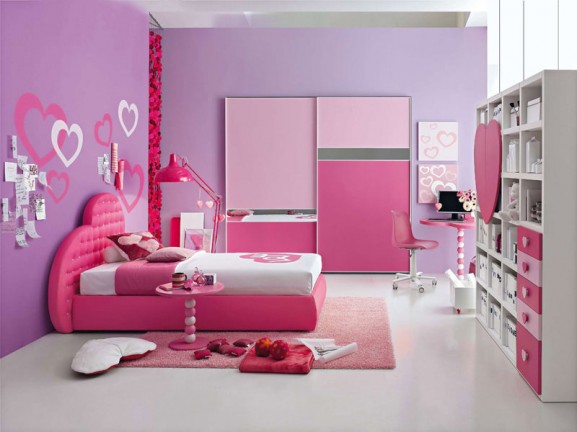
By Relocation.com
After all of the tasks related to moving are completed there is the question of decorating that you will have to deal with. Decorating a bedroom can be a fun bonding activity between you and your teenager. For a teen, their bedroom can be their sanctuary, and so you want to make sure it is a place where they feel comfortable in. You can be involved with making the decisions, but you should also consider what your teenager likes (if you don’t know – ask!) So, here are some quick tips to help you and your teen with this decorating task.
Budget.
Setting a budget is important, so you don’t go overboard and your teen will have a realistic expectation what he or she can do with their room. If you’re doing major renovations, then you’ll probably have to set a bigger budget than if you’re just going to paint or wallpaper the room.
Design and Color.
What type of teen do you have? Is she a girly girl or a punk rocker? Does he love sports or playing video games? Let your child choose what theme and design his or her room will be. Don’t let them decide everything; after all, it’s your home. For example, painting the room black may not be a good option if you plan to sell the house in a few years. Getting hot pink carpet may be your teen’s idea of a fun time, but think about how it will affect the value of your home. Have them come to you with different ideas and then you can choose together. The idea here is to compromise.
Space.
Aside from what color walls or accents you’ll have, you’ll also have to consider the space. Your teen will want a bed and a place to study. If you’re buying furniture, you have to make sure that they’ll have a place in the room. Storage options are also important. If the room doesn’t have a built-in closet, they’ll need a clothes closet. You’ll also need shelves for books and other things they want to display, and perhaps some out of the way storage for things they don’t use often or for seasonal clothes. Under the bed storage can help you save space in this case. If the room is large, maybe you can add an exercise or lounging area as well.
Accessories.
Much like in fashion, accessories can make or break a room. If you’re just doing minor decorating, things like curtains and sheets can really change a room. Get sheets, pillowcases, curtains, towels, even shower curtains that match your theme and design. Or you can add a touch of color with small things, like lampshades and carpets to make a big difference.
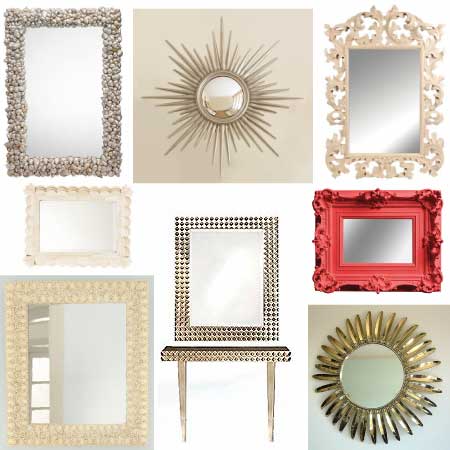
By Relocation.com
After you have settled in with moving you may be thinking about some ideas how how to decorate your room. A fun way to do so is with mirrors. A well-positioned mirror in a rooms can brighten it up, as well a giving it an illusion of space – perfect for diminutive spaces! So, if want to use mirrors for your home, check out these unique and creative mirror decorating ideas.
Create your own Design.
You can purchase mirrors cut out in different designs, but why not make your own? A sunburst mirror design will be perfect for any room, and you don’t have to break the bank (or a couple of mirrors) to do this. Take a large circular mirror, and several rectangular ones. Place your round mirror in the center, and then position the rectangular mirrors around it, making it the “rays” of your sun. You can also make other designs from pre-cut mirrors, just use your imagination!
Bathroom Decor.
Your bathroom should have at least a small mirror, usually over the sink. But, you’re not limited to that. If you have a small shower stall, you can install a full-length mirror inside to help create an illusion of space. You can also put a mirror on the walls or on the door, so you can give the bathroom a more open feel.
Light up Your Living Room.
If you have a small, cramped living room, placing mirrors inside will help you create that illusion of space. However, a more creative use would be help you light up the room. You’ll have to position the mirrors in such a way so that it catches and reflects light. One way is to take several full-length dressing mirrors and hang them horizontally in panels across your living room. This position catches the light and reflects them in interesting ways. Another would be to cover on side of the room with mirrors, and then place a couch in front of it. This creates a seating area and focal point for your living room.
The Bedroom.
A mirrored headboard is an interesting focal point for your bedroom. You can find several types in the stores or you can simply make your own. Of course, don’t just get a full-length mirror and turn it sideways. Do something unexpected, like taking small mirrors and positioning them to make a headboard. Or, you can take up the entire wall as the headboard and place mirrors all over. If you want something simple, a decorative round mirror placed above your bed can make an elegant statement.

By Maria Paulia Belgado
Moving during the winter is a unique moving situation. You have the weather to deal with but there is also the holiday season and decorating as well as the unpacking your moving boxes! One item to decorate is a Christmas tree. Before you decorate you will have to choose a special one to bring home.
Choosing a Christmas tree is very exciting, especially for those little ones who are awaiting Santa! Many people have certain ideas for what a good Christmas tree should look like – healthy and lots of branches for those decorations. However, what else should you look for? Check out these tips to help you pick a winner!
Variety really depends on your where you’re located. On the West Coast, you’ll see a lot of Fraser Firs and Monterey Pines, while if you’re sourcing your tree on the East Coast, you’ll have a choice of Cedar Red, Virginia Pine, Sand Pine, Leyland Cypress and Spruce. It’s a good idea to choose a tree with shorter needles, as it will be easier to hang your decorations.
Perhaps more importantly, what you need to consider is size and height. Figure out where you want to place your tree and measure the height and width of the space. Of course, make sure you make space for the base and any toppers. Take a tape measure with you just to make sure. When choosing a place, make sure it’s away from heat sources (like fireplaces or vents) or away from traffic, as too much movement will shake off the needles.
Once you get to the tree farm or wherever you get your Christmas tree, make sure you give your choices a thorough examination.
Make sure its fresh. Are you cutting fresh or choosing from pre-cut trees? If you cut your own, then you can be sure of the freshness. If you’re buying from a lot of pre-cut trees, make sure you check the needles. They should be strong – take a handful and gently tug on the branch. The needles should stay on the branch and not fall off. Try to pull a branch down to the ground to check if the needles stay on the branch. Usually, a couple should fall off, but not too many. Give it a good smell – it should have a fresh fragrance and have a good dark green color.
Consider the decor. You should be able to hang your decorations, so the branches should be strong and have spaces for you to place them in. Take one of two decorations with you when you go tree shopping. You can try them out and see if they look good or if the tree will be able to hold them.
Hopefully, you’ve brought a car or van that can fit your tree (you’ll be surprised at how many people forget the fact that they have to bring it home!). You can ask the tree farm if they deliver as well. Once you get it home, set it up, keep it fresh by keeping it watered and you can enjoy trimming the tree with your family.
Have your area setup. You should have a tree stand with some fresh water ready. It should be steady so it doesn’t tip over. Help young kids if they want to decorate – you don’t want then to hurt themselves on the needles or accidentally knock the tree over. When you’re done, you can enjoy how the tree looks and smells!

By Maria Paulia Belgado
In the last few years, people have been concerned about the state of the environment – from global warming, to deforestation and saving endangered species, it seems every has “green” on their mind. So many things have “gone green,” from business practices, to the moving industry to fashion and even home decorating. Our homes are the best place to start if we want to be environmentally-friendly (as well as teaching our kids to be.) Of course, it’s not just about being chic and in-style, but you may find that keeping toxic materials and chemicals out of your home can do a lot more for your health. With these bedroom decorating tips, you’ll find that it can be easy to be green.
Clear the Air, Save Some Cash.
The quality of air in your bedroom is important; after all, you breathe it in and out for at least 8 hours per day. You can install from filters and air purifiers, but you don’t need to spend that much. One great way to clear the air is to install fans in your bedroom. These will not only save on your power bill, but also ensure that your air keeps flowing and doesn’t get stagnant. Also, get some lighter curtains that can allow the sun to stream in – sunshine is the best bacteria killer and will also prevent molds and mildew from accumulating in dark, damp bedrooms.
Green Your Bed.
The mattress is the most important part of your bedroom – make sure it’s not harming you and the environment. Many conventional mattresses contain toxic chemicals and contains polyurethane foam which is bad for the environment. Instead, choose organic mattresses, usually made of wool, cotton or latex which are all farmed organically. These are durable materials and provide the same comfort as regular mattresses, so there’s no need to sacrifice quality for eco-friendliness.
Don’t Forget Your Bedding.
Next, you can get some organic beddings, as well. Organic cloth made from cotton or bamboo are the best, as these are not treated with formaldehyde to make them soft. Cotton plantations use about a third of the world’s pesticides, so buying organic cotton, made without any chemicals will make a big difference. Bamboo, on the other hand, is a fast-growing, renewable resource. Of course, when you decide to go green and replace your old bedding, make sure you recycle them, whether that means turning them into something useful like pillow covers or rags, or donating them to a shelter.
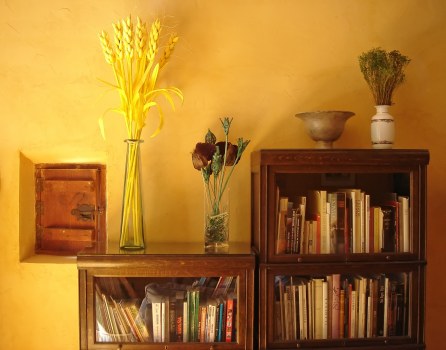
Follow our tips to brighten up and decorate your small space
With small apartments or homes, decorating your small space can be a challenge. Since your home is a reflection of your personality you want it to be warm and open showcasing your interests in music, art and culture.
Keep it natural. For small spaces, you will need maximum openings to help with natural light. Make sure your blinds and curtains do not block any artificial and natural sources of light; doing so will make your room look dry and cramped. Avoid using heavy and dark window curtain as they reduce the visual area of your room. Make sure you use clear or light colored glasses for your windows. Arrange your furniture such that it doesn’t block light. Sparkling clean windows will add more volume to your room.
Huge and block-like furniture pieces will your small rooms look even smaller. Try placing light and informal furniture pieces that make your small room stylish. Do not place your chairs or sofas in front of your windows. Placing furniture in front of your windows reduce the length of your small spaces. Low profile furniture pieces are best suited for small spaces. Make sure you add furniture which is comfortable and keeps free space in your room.
Monochromatic color schemes are best suited for small spaces. This means you should use different shades of the same color. This trick works best when you use a neutral color, like white, along with it. Using variations of a single shade make small spaces look larger, open and not cluttered. You may also consider adding exciting textures.
Even of your space is small, it should be converted such that it has enough place for everyone. There is potential in all small spaces to be converted into stylish areas. Even if your space is small, there are corners which can be used effectively. Add reading lamps or slender hall lamps to brighten up those corners. You can easily give volume to your small space by highlighting your dark corners. Setting slim and tall hall lamps will also throw light to your ceiling and make the entire room glow.
Keep your floor area clear. Using up floor space will reduce the area of your room. Adding shelves and wall racks will make your small space attractive and also provide better storage options. There are several kinds of materials which can used to create decorative shelves.
Your space should also be free of clutter. A cluttered space feels not only disorganized, but cramped as well. If you want to project more volume in your small spaces, art and accents should be sparingly used. Adding few favorite accents will do the needful. You may also shuffle your accessories to change the look of your small spaces. While adding paintings, make sure you add the ones which are rectangular and sleek. Don’t cover all your walls with paintings; there must be enough space between two paintings, and it will make it look less cluttered.
Decorating your small space doesn’t have to be difficult. Using a little creativity and imagination can transform your small spaces into livable and wonderful areas.

Check out some of our Thanksgiving decor ideas to spruce up your home for the big feast!
By Maria Paulia Belgado
Special to Relocation.com
It’s almost that time of the year – Thanksgiving! Everyone’s looking forward to the feast – the turkey with trimmings, stuffing, green beans, sweet potatoes and pumpkin pie. So you’re pulling out all the stops to get the dinner ready and sparing no expense. But, have you thought about your Thanksgiving décor? You want your guests to feel the spirit of the holiday, so you’ll have to get your home worthy of your amazing turkey feast, with these simple Thanksgiving decorating ideas.
Outside the Home:
First off, welcome your guests in style even before they enter your house. Make sure your lawn is clean and neat by raking all of those fallen leaves. If you have a porch, you can decorate your home with some large pumpkins, gourds or Indian corn in strategic corners, or you can use them to line the walkway to your front door. On your front door, hang a nice autumn wreath. You can get a pre-made one or do it yourself. Take some twigs and branches and form it into a circle; use zip ties or twine to hold it together. Decorate with leaves, pinecones, mini-pumpkins and other fall items. This will make a nice addition to your door.
The Living Room:
The living room is where you’ll be entertaining your guests before you sit down to dinner. It’s easy to decorate your living room by just adding splashes of color here and there. You can put some fall color throws on your couch, and some pillow as well. Place some more pumpkins, gourds and corn on your coffee table, arranges artistically to make a nice display. If you have a fireplace, make sure the fire is going when your first guests arrive. Also, serve hot chocolate or warm apple cider while they are waiting. Here’s another great tip – on one corner, put up a poster (you can have the kids help design it) where people can write down what they are thankful for. It will make a nice souvenir to keep, and a great tradition to start each year.
The Dining Room:
Of course, the dining room is where all the action will take place. You’ve worked hard on your feast, so make sure it has a fabulous stage. Take out your best china and silverware since it is a special occasion. Again, the gourds, corn and pumpkins can be placed in the middle, or you can use other fall favorites like apples, maple leaves, and dried flowers. Add a few candles as well, to bring a romantic mood. However, if you want something a little more elaborate, you can have cornucopia, the most traditional of all Thanksgiving decorations, that signifies a bountiful harvest. You can make it out of paper plates or buy pre-made ones, and it makes a beautiful symbolic centerpiece for Thanksgiving.
With a little creativity and some time, you will be able to make your home a beautiful backdrop to accompany your fantastic Thanksgiving feast.

Is your closet a mess? Check out these tips to help you get organized!
By Relocation.com
Storage can be small to almost non-existent in a small apartment. Your closet, whether it is used for clothes or other things, is mean to keep things in place and out of sight in order to keep your room clutter free. However, most people just pile their things into a closet, without thought of what it looks like. It is important to keep the inside of your closet neat as well. You’ll be able to keep your things neat and clean, as well as maximize your space so you can fit more inside. Here are a few tips so you can get started on getting your closet organized.
1) Clear it out.
If your closet is so full you can barely close it, then it’s time to get rid of some things. The easiest way is to start emptying your closet and placing things in piles or boxes – those things you should keep and things you should give away. Be impartial and practical when you decide on what to keep and get rid of. If you haven’t worn it in a year, chances are you’ll never wear it again. If you’re waiting to lose those 10 pounds to fit into your old jeans – don’t! Give it away and buy new, slimmer jeans if (or when) you do lose that extra weight.
2) Use every inch of your closet.
Are you using every available bit of space inside your closet? Shelving is important to make use of vertical space, and if you don’t have any built it, you can easily find stacking shelves that you can place inside so you can fit more items in. Look as every nook and cranny to find ways to add more storage. How about the closet doors? You can attach hooks to your closet door and hang shoes, scarves, belts, ties and bags.
3) Organize visually.
Use your eyes to organize. What does this mean? First, you should keep the things you need often at eye level, so you can easily get to them without disturbing the closet’s organization. Next, organize things by color. That way, if you’re looking for a particular red shirt or yellow dress, your eyes will be drawn to that particular corner of your closet and you can quickly get to it. The same can be said of organizing shoes. Keep them in clear boxes so you know what’s inside, or else, take a photo and place it outside the box so you know which is which.
With these organizational tips, you can easily maximize your closet space and keep your things in order. With a neater and orderly closet, you’ll be able to access the things you need easily and keep you space from being cluttered, which may also make moving that much easier.

Spruce up your home with some curb appeal
By Relocation.com
Your front yard is one of the first things a homebuyer will notice. You may have brand new kitchen appliances, or have excellent hardwood floorings, but if you don’t have curb appeal, buyers may not be interested in checking out the interiors of your home. One of the best ways to reel in potential buyers is to curb appeal. Here are 10 ideas to make your curb look attractive.
1.) The exterior home: Before starting on your yard, check the physical appearance of your house. Take a look at the entire neighborhood and get a general idea about colors. Try and choose colors that stand out among other houses but are not very loud. Pressure washing bricks and curbs is also an excellent idea.
2.) Highlight your home: Make sure to accentuate the features of your home. If you have a drive way you could install lights or have decorative pillars that lead a way to your home. Having beautiful plants and shrubs will also add in curb appeal.
3.) Interior decorations shouldn’t hamper the exterior appeal: Several homeowners decorate their home such that they hamper the exterior beauty of the house. Your interior furniture and fittings should not be seen if you are standing on your curb. Your curb should be an extension of your interiors but it should have its own identity as well.
4.) Entry areas and walkway: Your entry areas and walkways are one of the most important factors of your home. You can improve the look of your sidewalk, driveway, and stairs around your house by removing all debris, weeds, and washing your pavement. If you park cars on your driveway, make sure you clean all oil and petrol stains.
5.) Keep unsightly items away: Curb appeal is associated with the way your family lives. Garbage cans, debris, trash bags, and gardening tools must be kept away from your curbs. These items will give your house an unkempt look, and help homebuyers form negative opinions about your home.
6.) Manicured gardens: Make sure your grass is cut and trimmed at regular intervals. If you have flower beds or shrubs, they must be watered and cared for. For dead and dry spots on your garden, you can buy garden fixtures and hide them.
7.) Constant care is essential: Caring for your home must be a part of your daily routine. If you start caring for your house because buyers are coming, the effects may not have the same impact as maintaining it.
8.) Replace old items: Things like mailboxes, number plates and hardware that are installed in around your house have a major impression on the buyers. Buy new elements to replace the older ones.
9.) Spice up your outdoor furnishings: The appearance of your outdoor and patio furniture should be fresh and clean. These are considered leisure areas and should always appeal homebuyers.
10.) Add exciting colors: To get curb appeal, you must consider adding some color to your yard. Getting in colorful flowering plants and furniture will add additional color to the exterior section of your home.

By Maria Paulia Belgado
Special to Relocation.com
The holidays are upon us again, and first up is the frighteningly delightful celebration of all things ghoulish – Halloween! It’s that time of year when the young (and young at heart) dress up in celebration of All Hallow’s Eve. Dressing up isn’t just for your kids – you can dress up your home as well, to welcome trick-or-treaters or guests for a Halloween Party. To help you along, here are some Halloween home decorating ideas to give your home a festive new look.
Idea #1 Scary Carved Pumpkins:
Pumpkin carving is a Halloween tradition, and is a great activity for kids (though the young ones should be supervised!) If you’ve never done it before, it’s easy to make your own Jack-O-Lantern. Take a fresh pumpkin – the bigger the better – in a shape you like. Draw a circle on the top, around the stem, and cut carefully. Take the top off and set it aside. Scoop out the insides and throw it out. Now, draw a scary face on the side of the pumpkin, and carefully cut it out it a small knife. When you’re done, place a small votive candle inside and put the top back on. And there you have – a pumpkin carving worthy of Halloween! Do this with several pumpkins and place it along your porch or front yard to greet your guests.
Idea #2 Spooky Scarecrow:
A scarecrow isn’t just for the birds – but it can be fun for Halloween too. First, carve an extra pumpkin (same instructions as above) and set it aside. Take some old clothes, like a shirt and pants or overalls, and stuff it with straw. Sew the top and bottom together to make the scarecrow body, and cut out a hole between the legs. Then, drive a large stake to the ground, and push your scarecrow body through the stake, leaving some room on the top. Secure it with some twine if you need to. Now, take your carved pumpkin, cut a hole in the bottom for the stake, and place it on top of the body. Top it off with a straw hat and there you go – a spooky scarecrow to frighten (and delight) those trick-or-treaters!
Idea #3 Holiday Wreath:
Not all Halloween decorations need to be scary. Halloween is also when fall is in full swing – when the leaves turn brown and fall to the ground and crunch beneath our boots. Celebrate this time of the year with a holiday wreath. It’s really easy to make, if you have the right materials. You’ll need a circular frame of some kind, and you can cut one out of Styrofoam or you can use an embroidery hoop. Using crafter’s glue or a hot glue gun, you can attach all kinds of fall-related items to the hoop. It’s good to have a base material of some kind, and usually, brown twigs are a great base. Just take the twigs and glue it to the frame, in the same direction. Then you can attach all kinds of things to it – pine cones, leaves, miniature pumpkins, small ears of corn, etc. Or if you want to keep with the spooky Halloween theme, then you can use plastic spiders, vats, skulls or mini Jack-O-Lanterns.
These are just some of the basic home decorating ideas for Halloween you can do to prepare your home for this fun and frightening holiday. Be creative and try your own decorating ideas – there are no rules and remember it’s all for fun!

Learn what you need before you purchase a new refrigerator.
By Dermound Becker
Special to Relocation.com
Out of all the appliances and gadgets in our homes, a refrigerator is the most important and one item we simply cannot live without. It is also a very costly appliance to purchase, so one really has to know what to look for and what each model provides. To begin, you will need to know the size of the fridge you need, not only so that the new one will fit into its designated place in the kitchen, but also because if you buy one that is too large, it will use a lot of unnecessary electricity. The reverse also applies, in that if you buy one that is too small for your needs and it is stuffed to capacity most of the time, it will also use more electricity as it struggles to maintain the ambient temperature.
On the topic of electricity consumption, it is to be noted that the very popular side-by-side fridge and freezer units are the least energy efficient and therefore use the most electricity so, if your electricity bills is on your mind, it is advisable to look for a model that is more ecology friendly and energy efficient. Also, the fridge you purchase should have an Energy Star, as any model bearing this mark will save you up to 50 percent in electricity costs; those that do not will be at least 20 percent less energy efficient.
Consumer magazines report that those models of fridges which have a through the door ice make and dispenser are the models which break down the most and therefore need the most repairs. For this reason it is wise to consider having ordinary ice cubes in the freezer section, as fridge repairs are notoriously expensive.
Refrigerators with a freezer at the top are generally less expensive than models with a freezer section at the bottom. All the manufacturers of fridges on the market generally have a choice of internal features, such as shelves made of tempered glass which are not easy to break, special temperature controlled units for dairy and vegetable storage and adjustable shelving. All of these are a matter of personal choice.
Color is another important factor to consider, as the fridge should blend in with one’s existing kitchen, but it must be noted that a stainless steel or special color finish is more expensive than the regular white or cream painted finishes most commonly found.
When you have decided on the exact model of fridge you would like to purchase, approach as many reputable suppliers as you can to see which one will give you the highest discount and the best offer on the repair and warranty package. Also, ask if they will waive the charge for delivery and installation and if they would be willing to take away the old model. This will save you a great deal of money, as every outlet is fighting for a sale in these hard economic times.
Don’t forget to like us on Facebook and follow us on Twitter!
• Follow us on Twitter @Relocation_News
• Become a fan of Relocation.com on Facebook

Know what to look for when seeking to hire a contractor.
By Dermound Becker
Special to Relocation.com
When it comes to hiring a contractor to do work in your home, you need to take your time in choosing just the right one for you. A contractor is going to have people spending time in your home, so they need to be trustworthy and professional. Here are some helpful tips for choosing the right contractor for you.
• Get as many bids/quotes as you can. Not only are you looking for a good price, but the more quotes you get, the better idea you have as to what the going rate in your area is for the work you want done. Remember, though, that the cheapest quote may not prove to be the best contractor for the job. Ask if the quote is a hard quote (the actual price that you will be charged) or just an estimate.
• Ask for references and then, actually call the people. Find out if the job was completed entirely to the customer’s satisfaction. Was the work completed on time? Was the work site kept clean and safe? How close was the final bill to the estimate that was provided? And would they consider hiring this company again.
• Is the contractor fully insured, licensed and bonded? Are ALL of his employees insured as well? The employees should be covered by workman’s comp and liability insurance. Also ask if the contractor is a member of any trade associations.
• Check online for litigation history for the company. If they have been sued a number of times, this would be a definite red flag. You should also call the Better Business Bureau. They can provide you with a lot of useful information as to the company and its business history in the area.
• Find out how long the contractor has been in business. As a general rule of thumb, a contractor that has been in business for at least five years is probably reliable. It is difficult to stay in business that long if they are doing shoddy work.
• Ask if the price covers everything, such as permits, materials or blueprints . You should know the actual cost before you start working with a contractor.
• Make sure you choose a contractor that you are comfortable communicating with. Does he or she really listen to you? Are they taking what you want done seriously? After all, this is your job, your home and you should have the final say in decisions. The contractor should have ideas to present to you, but you make the final decision.
• Is the contractor going to be easy for you to reach if you need to? They should respond to your messages the same day.
You should realize that problems can arise. Weather, material problems, any number of reasonable problems can pop up and slow the course of your home improvement project. The contractor should communicate fully with you about these. But make sure that it clearly states in the contract before you sign it what will happen if there is a dispute. Mediation is a lot less costly than having to go to court.
Choose wisely and your home improvement project should go through without a hitch.
Don’t forget to like us on Facebook and follow us on Twitter!
• Follow us on Twitter @Relocation_News
• Become a fan of Relocation.com on Facebook

Learn more about how to deduct some expenses from your home office.
By Relocation.com
If you have a home office, you may be wondering if you can take the home office deductions from your income tax. If you are self-employed and you use some of your home as your office or primary work area, then you probably can take the deductions. It can be tricky to figure some of this out, but it is worth the time.
Does your space qualify as a home office?
The IRS uses two terms that determine whether or not a space is truly a home office or not: exclusively and regularly. ‘Exclusively’ means that some part of your home is used ONLY for your business. For instance, if you have set up space in your garage for your office but you are still using part of that garage for storage of winter clothes or toys, then it is not being used exclusively for your office. Thus, you can’t say your garage is your home office. The kitchen table doesn’t qualify either. But if you have cleaned out a bedroom and made it your office, then it would qualify.
‘Regularly’ means that you are using your office space on a regular basis. You can’t take the deduction if you only work there a couple of weeks a year, for example. You must have used this space on a consistent basis. If you use that space for, say, six months out of every year, then you can only calculate the deduction for one half of that year.
One exception is if you use part of your home to store inventory. You can take the deduction even if you used that space for some personal use when your inventory ran low.
What percentage of your home are you using?
In order to take the deduction, you have to determine just how much of your home is dedicated to your home office. This can be done in one of two ways. First, if you are using a bedroom in your home, and your home has six rooms, then you are using 1/6th or 16 percent of your home for your office. The other way is based on square footage. If your home is a 2,000 square foot home and your office is 200 square feet of that area, then you are using 10 percent.
What deductions can I take?
If you can qualify for the home office deductions, then you can take many deductions. Some are:
• Direct expenses: money you spend to maintain or repair the office area.
• Indirect expenses: Whatever percentage of your home is your office, you can take that percentage off things like your mortgage or rent, utilities and insurance.
• Interest and property taxes can be deducted by the percentage of your office area
• Depreciation: This can all be tricky, and if you don’t want to face an audit from the IRS you may need to have a tax professional figure it all out for you. You need to keep records of everything.

Keep cool this summer without raking up your electricity costs.
By Stephen Davis
Special to Relocation.com
In the summer, electricity bills can increase – especially in warmer areas in the south and west. During such periods of heat electricity consumption needs to be kept low. The key to this is efficiency and to use resources wisely.
One of the first things that you should remember is to keep your shades and blinds closed. This prevents the sun from heating up your home and wasting energy. Incandescent bulbs and other similar light sources also produce heat just like the sun does, so it is better that you keep extra lights off. A dark area generally gives a cool feeling anyway.
Hot air rises, so keep the vents and windows of the lower rooms closed. This will give the rooms upstairs more air and keep them ventilated and cool. Keep the vents and windows of the upper rooms open to the hot air escapes that way.
Also find out the sources of heat in your house. Cloth dryers use a lot of electricity and in addition to that, they also produce a lot of heat. Always install dryers near a window and have an air pipe made or an exhaust fan installed to channel away the hot air. Dryers that are placed in basements should have proper ventilation too or the hot air will escape into your living room through the stair case.
You should take a tour of your house and examine any openings from where cool air might escape. Remember cool air is heavier and will escape from places closed to the floor. This includes the spaces under doors. Some doors have a large space underneath them. This wastes a lot of cool air. Install strips of carpet or rubber at the door edges to act as a barrier to the cold air.
Human bodies also produce heat, especially during active actions like exercises. Do not do workouts indoors. Use your lawn or the local gym. The less activity there is inside the house, the cooler it will stay.
Many people keep on changing the air conditioner thermostat. This isn’t a wise idea as it uses more energy. Keep the air conditioner at one constant temperature. It will always cool better that way and consume less electricity as well. If you have a central air system, keep the fan on “On” instead of “Auto”. This will keep a steady airflow through your house and maintain the temperature beautifully.
Use pleasant weather wisely. Place a box fan in a window early in the morning and open the opposite window. This will circulate the fresh morning air through your house and cool it down.
In many areas, the air conditioner is not really necessary. Learn to live without it unless absolutely necessary. In many cases, the ceiling fan can do a nice job by itself.
Try if it works. Using less air conditioning will bring down electricity costs considerably.
And by the way, since it is the summer; go outside. Visit the beach, lake or riverside. Go to water parks and have picnics with friends. When you leave, make sure everything is turned off.
Don’t forget to like us on Facebook and follow us on Twitter!
• Follow us on Twitter @Relocation_News
• Become a fan of Relocation.com on Facebook

By Dermound Becker
Special to Relocation.com
For many, gardening is one of life’s greatest pleasures. When considering what plants should go into your garden, herbs are an excellent choice. Not only are they a boon for your culinary skills, but they all come in varying shades of green, have differently shaped leaves and lovely scents, thus making your garden interesting to look at too. It should also not be forgotten that certain herbs can be used for natural remedies and cures. If you need some herbs in cooking, you simply cut off the amount you need and the plant will show no signs damage and its growth will not be hindered.
Parsley. One of the most versatile of all herbs is parsley, which is used in many recipes. It grows in clumps of bright green stems and leaves up to a height of around one foot. Parsley is known to keep away the common house fly which is good enough reason to plant this hardy herb.
Rosemary. Rosemary is a very strong and hardy herb which needs little water and thrives in direct sunshine. It grows in bushes with fronds of thin, elongated leaves and, in spring, has dainty little lilac or purple flowers along the length of its fronds. Rosemary is known as the calming herb and one can simply steep it in boiling water for a few minutes and, when cool, sipped; and this ‘tea’ is also a mild antiseptic.
Chives. Chives make a pretty addition to a small garden. A part of the onion family, it has a mild flavor. Chives are a bright, strong green and they grow vertically in long, thin blades similar to grass, which make a good visual contrast to other bushier herbs.
Basil. Also known as sweet basil, is another popular small garden herb as there are green, red and purple varieties, which add a color contrast to your small garden. The red variety has small pink flowers; and this herb grows low on the ground, thus making it great for a border.
Mint. Finally, mint adds a lovely fresh scent and bright light green leaves to your herb garden. Mint is another herb which keeps away the house fly and its other uses are many. It is used to make a tea by steeping it in boiling water; and may be added to traditional tea and lemonade. Mint can grow quite tall, so it should be planted at the back of your herb garden and it needs to be trimmed occasionally, as it can grow out of control.
These herbs can be planted either in the soil of a small garden, or in individual pots and arranged in an attractive formation. As they are all hardy, they can be dug up with their roots to be transported to another location or, if in pots, wrapped in bubble plastic to protect them when being transported.
Don’t forget to like us on Facebook and follow us on Twitter!
• Follow us on Twitter @Relocation_News
• Become a fan of Relocation.com on Facebook

Follow our simple tips when learning how to compost.
By Maria Paulia Belgado
Special to Relocation.com
Whether you own a country cottage that has large gardens or a posh city apartment with a few flowerpots, you should consider composting to benefit both your garden and the environment. Composting is essential, as it keeps waste products away, and fertilizes the land without any chemicals. It works by degrading plant substances into humus, which is very rich kind of fertilizer. In simple terms, composting means recycling plant products to create something useful.
There are several ways of creating compost. These include heaping up leaves and hay and allowing the pile to decompose. However, if you wish to decompose kitchen waste, try mixing dry and wet scraps in a silo and allow it to be aerated. This will create heat and help with the decomposition. This process can be used by apartment dwellers. However vermin composts are best for people living in flats. In vermin composts, essential bacteria decompose kitchen scraps into smaller particles and create food for the worms. In turn the worms excrete moist, odorless and rich compost.
There are several kinds of worms found for this purpose, but most use the red wigglers. These can be purchased online, or from bait shops and garden centers. After you have bought the worms, cut a newspaper into thin strips and place it at the bottom of a container, and moisten it with some water until it’s damp. Then, place the worms and the mud that came along with those. Cover the container and place it in a cool and dark place, making sure the temperature is not too hot or too cold.
Now is the time to feed those worms. Put in kitchen scraps and cover with mud in one corner. After a few days, add more scraps in another corner. Rotate these corners every time. The first will be ready by the time you reach the last one. Whenever you add wastes, make sure you bury in rotation. Few months later, there will be less paper and lots of crumbly, brown stuff in the container. The compost is ready. Once the compost is ready, you can easily scoop it up and use it. To create a new set of compost, clear all the materials of the container and repeat the entire process again.
If you want to have good quality compost you should also avoid garlic, spicy and salty stuff, which are poisonous for worms. These worms will reproduce while they are decomposing your scraps. In case of overcrowding you can donate those worms to schools, bait houses or to a plant nursery.
All of these methods mentioned above are really low-maintenance and easy for you. The best thing about composting is that it is free, fabulous and extremely useful for your plants. The humus you create from your own wastes and scraps will help your plants stay healthy and thrive well.
Don’t forget to like us on Facebook and follow us on Twitter!
• Follow us on Twitter @Relocation_News
• Become a fan of Relocation.com on Facebook

Recycling is a great way to start with your budget home designs.
By Maria Paulia Belgado
Special to Relocation.com
When decorating your home, have you thought about the impact your decisions make on the environment? These days ‘going green’ usually means paying a premium, just to save the environment. Organic food, biodegradable packaging, eco-resorts – all these things cost at least 25 percent more than their regular counterparts. However, no one said this was a rule – in fact, doesn’t it seem silly in a way, that to be environmentally friendly has to cost more?
But, you don’t have to spend a lot just to save Mother Earth. In fact, you can still be eco-chic, without breaking the bank, with these green design ideas:
First things first – recycle!
Don’t just throw out everything you own. See if there’s anything at all you already have that can be reused in any way. Maybe all you need to spruce up your living room is some new pillows. You can sew new pillow covers using fabrics you have lying around the house. How about those pretty curtains you’ve never put up or maybe some pretty scarves which have gone out of fashion. Before you go to the store and reach for your wallet, look around the house first.
Also, you don’t have to buy everything 100 percent brand new. Go to thrift shops, the Salvation Army or garage stores and turn someone else’s junk into your treasure. You’ll never know what fun and unique items you’ll find, at cheap prices too!
Repaint.
One of the cheapest ways to really change up a room is with a coat of paint. Choose eco-friendly, non-toxic paint with low or no VOC (volatile organic compounds). These might end up costing a little bit more, but instead of calling an expensive painting company do it yourself! This way, you can save money and you can reduce your carbon footprint since you don’t have to ask someone to come in and drive to your home.
Make your own décor.
Why pay a lot for artwork for your walls, when you can make it yourself? Have your own photos done at your local printshop and frame it, so you can hang it on your empty walls. Or why not assemble some old jars and bottles, fill them will pretty stones or seeds and use that as an accent or centerpiece? Eucalyptus leaves last for a very long time and can be used to decorate your bathroom, as well as give you some natural aromatherapy. Cut some stems and wrap them at the end with some recycle ribbon or string. Hang it upside down your shower curtain rod to bring some real green into your bathroom.
Think small.
There’s no need to replace your entire kitchen or living room and spend a fortune just to be eco-friendly. Replace your light bulbs with more energy-efficient ones. Or why not get some inexpensive heat-inductive cookware – these make sure your food is heated up evenly, and therefore you use up less energy to cook. Instead of using harmful chemicals to clean your countertops, use some good ol’ vinegar and water.
There’s no need to blow your budget, especially in today’s tough economic times, just to go green. By thinking creatively, you can save a lot of money, have an eco-chic home and help save the planet.
Don’t forget to like us on Facebook and follow us on Twitter!
• Follow us on Twitter @Relocation_News
• Become a fan of Relocation.com on Facebook

Now that the kids have moved on it's time to think of how you will remodel their old room.
By Faith Teel
Special to Relocation.com
It’s that moment that every parent looks forward to with excitement and dread: your child has gone off to college or moved into their own apartment. Their room is empty, the bed is always made and no rock music comes blaring through the walls. Now what?
Whether this is a sad moment because you miss your child, or a happy one because the house is more serene, or a little of both, you still have to decide what to do with their room. Even for parents that miss their kids, the best course of action may be counter-intuitive: many experts recommend remodeling the room for a new purpose so that it doesn’t constantly remind you of the past.
If you are concerned that your child won’t feel welcome when he or she returns for a visit (or for summer break), you can discuss the changes with him (or her). Here are a few things to think about before you have your talk:
• Will your child want any of the furniture in the room? If not, can the furniture be re-used, or should it be sold or thrown away?
• If he or she has left keepsakes behind, what can be thrown away? What can be stored? Consider displaying the most precious items (such as trophies or pennants) so that your son or daughter still has a place in your home.
• As you update the room to suit your tastes, can you make concessions to your child’s taste? For example, if you want to paint the walls gray but your daughter loves pink, perhaps you could add pink accents in the lamps or curtains.
As you decide how to redecorate the room, think about how your life will change in your child’s absence. What hobbies will you pursue? Will you exercise more? Once you have a grasp of how you’ll use all of your new free time, you can update the room to accommodate your new lifestyle.
Here’s what other “empty-nesters” have made in their extra space:
1. A home office:
Whether you’re thinking of starting your own business or just need a place to keep your bills, a home office can help you stay organized.
Suggested amenities: add a computer desk, computer chair, shelves and filing cabinets.
2. A sewing room:
Experienced sewers know that you’ll get more done if you can keep your sewing machine out where it’s easy to access, instead of having to pack it up each time you finish a project.
Suggested amenities: add a sewing table, cutting table, quilting frame, thread organizer, shelves for storing fabric.
3. A game room:
Do you and your friends get together to play poker or Uno? Why not set up a place for social card games?
Suggested amenities: add a card table and chairs, mini-fridge, game-themed decor and the games themseleves.
Tip: Don’t go overboard and buy every single game out there. Pick three-five of your favorites and make it a point to have friends over once a month for an organized game night.
4. An art studio:
Have you always wanted to tap into your creative side? Now that your kids are grown up (or almost grown up), you may have more time to paint or craft.
Suggested amenities: add corkboards for pinning ideas to, tables or easels, shelves to store supplies, a clean-up sink (for painters), paint, brushes, etc.
5. A media room:
Do you love to watch movies? Why not make your own home theater? The room can have furnishings as simple as a couch and a television, or you can go wild with theater seats and surround-sound!
Suggested amenities: room-darkening curtains (for watching during the day), comfortable seating, a DVD player, etc.
6. An exercise room:
Perhaps you already exercise regularly, or perhaps you’ve been putting it off. Either way, you’re more likely to keep in shape if you have a pleasant space for your daily workout.
Suggested amenities: exercise mat, exercise equipment, inspiring pictures and a music system.
7. A large closet:
If you have a big wardrobe crammed into a small closet, consider making the bedroom into a luxurious walk-in closet.
Suggested amenities: cedar wall panels (an easy DIY project), sturdy closet rods and hangers, mirrors.
8. A “man cave”:
Does the gentleman of the house need a place to watch football games or finish his latest project? If so, consider remodeling the room to suit his tastes and needs.
Suggested amenities: mini-fridge, sound system, TV, comfortable chair, shelves and tables for hobbies.
Whether you’re planning an art studio or installing a home theater, your redecorating budget doesn’t have to be large. Scour Craigslist and yard sales for perfect finds, and don’t be afraid to repaint and reuse your child’s old furniture. In many cases, you can cut down on costs by keeping the flooring as-is. Reclaiming your space can enrich your life without draining your wallet.

Congratulations on moving in - now it's time to unpack and finally settle in.
You did it – you finally moved it! Although the moving companies are long gone you now have a sea of moving boxes, unpainted walls and a bare home to deal with. Before you go crazy with the unpacking, we advise setting up a plan so that you can quickly settle-in and enjoy your new home.
1. Go out to dinner. No, this isn’t a plot to aid in your procrastination. We simply think that taking break after the days (and sometimes months) leading up to a move is a healthy way to re-focus on your plan. Getting out of the house is a great stress-reliever that will (hopefully) allow you to think about something else other than those boxes at home. Plus, having a relaxed dinner is also a great way to check out a restaurant or neighborhood in your new town or city.
2. Make it a party. If you can’t manage to break away from your unsettled home, consider having a painting and/or unpacking party. This will allow you to ask for help by offering your friends food and drinks as well as they help you in making your house a home. Make sure you tell your friends to wear old or ratty clothes –painting isn’t pretty but it can sure be a lot of fun.
3. Unpack with purpose. Moving is a great time to unpack in an organized manner – meaning not just leaving your items unattended to for days, or the worst case, leaving them in boxes and shoving them in a closet! If you find that you don’t have room for certain items, consider storage or maybe giving them away. You want to establish a fresh start in your new place and not a continuation of the way you were living.
4. Don’t overdue it. Everyone wants to be settled into their new home and neighborhood as quickly as possible. The problem when you try to do too much is complete burnout. Give yourself a schedule – allotting time for breaks outside of the home. Sometimes what you think you can do in a week will actually take two or even three weeks. Don’t let this stress you out and realize the hard part (moving) is over.
5. Celebrate. We mentioned going out to dinner and having a painting party, but now that you have unpacked and decorated it’s time to really celebrate with a housewarming party! Invite friends in your area for a casual evening of food and drinks. If you are completely new to an area, have a small dinner party with just you and your partner and/or roommate. However you celebrate, make sure you site back and finally enjoy the fruits of your labor.
March 21st, 2011 by
Admin
Categories:
design and decorate,
Do It Yourself,
exterior projects,
Home Improvement,
interior projects,
Moving,
Moving Day,
Moving Industry,
self storage,
Storage,
storage facilities,
storage units Comments:
No Comments » 
Arm yourself with an arsenal of cleaning products to tackle spring cleaning!
By Serena Norr
It’s officially spring! Even though it’s still pretty cold out there, we are getting excited about shedding our bulky winter coats, getting a much-needed dose of Vitamin D and cleaning out our homes for the season. Spring cleaning is a great way to get rid of items that you no longer need by donating, tossing them or placing them in storage – making your home more functional and organized. Here are some simple tips to make your house a lean mean clean machine this spring.
1. Start with the windows. An often neglected part of any house, the windows are also the easiest places for dirt and grim to acclimate. Using a rubber-edge squeegee or a sponge, mix a bucket with water and some window cleaner. Wipe and repeat until the windows are spic and span. You may also need to use a dry cloth afterward to ensure that you removed all of the dirt. While your doing this make sure you also wash your window blinds and/or curtains.
2. Change your linens. Do you have frayed and broken down linens? Spring is a great time to try new patterns and update your home with lighter and brighter colors (think feel good colors for summer!) We love flowing duvets with pale greens, yellows and lavenders.
3. Clean the refrigerator. Your fridge should really be cleaned all the time, but the winter has a way to make it easier to acclimate containers of old food – leading to mildew and pretty nasty smells. Even if you do throw out old boxes of Chinese food before it goes bad, you (most likely) aren’t rigorous about cleaning out your entire fridge. Start by taking everything out (yes, we mean everything) and throw out anything that is old or has a strange smell and/or resembles something of a science project (e.g. mold). Remove the drawers and shelves from the fridge and wash off any dirt, crust or old food. You can also scrub difficult-to-get areas with a scrub brush and/or an old toothbrush. Throughout the spring and summer get in a habit of regularly cleaning your fridge and freezer by making it a part of your normal cleaning schedule (about twice a month).
4. Clean those rugs. Rugs and carpets can very easily acclimate dirt and dust (even if you regularly vacuum). In the spring, deep clean your rugs or carpets by using a strong cleaner or hiring a professional cleaning company. Since these solvents are pretty strong, be sure to keep the windows open and try to avoid staying where the carpets are for a few hours. If you don’t have rugs, make sure to sweep, scrub and mop your floors.
5. Go through your closet. Ah, the closet, the quintessential dumping ground for all seasons. Use the spring as a way to de-clutter your closet and make some sense of the mess. Start by removing any winter items – like bulky coats and sweaters – and place them into boxes for storage or storage bins to be placed under your bed or in your garage. If there are items that you don’t need (or really never use), consider this a time to get rid of them once and for all by donating them to a local charity or give them to friends and family members. Since it is getting warmer, you may also want to sell them at a garage sale. It’s up to you how you get rid of them but the main thing is that you actually get rid of them. This also applies to shoes, bags, belts and the random knick knacks that often have a way of getting tossed into closets.
6. Junk draws no more. Junk draws are called junk drawers quite simply because they are a nesting ground for all the random things in our homes. Instead of making it all about junk, make these drawers practical and useful. Start by taking everything out of your drawer in order to clean it. Look through the contents and decide – what you really need and what is just garbage. Is your drawer filled with random nails or old tape? If you don’t need it, you may want to toss it. Oftentimes these useless items just live in our drawers until moving day. You may also consider purchasing a storage unit for your drawers in order to keep your items organized and neat.
7. Don’t forget these drawers. Cleaning not only applies to your junk drawer but should apply to your medicine cabinets, silverware drawers, cupboards and clothing drawers. Get rid of any expired medications, clean your silverware and go through your cupboards for old food. You should also go through your clothing drawers – they same way you did through your closets – and get rid of anything you no longer need or use.
8. Update your look. Just like update your style, you should also do the same for the look of your house. Your home is a place to seek refuge and find comfort and you can’t find such peace in a home with dreary colors or one that has dirty walls. Start by washing and scrubbing the walls. Then decide on a new paint scheme. Before you paint the entire home, be sure you know your vision and what “look” you want for your new home. You can purchase samples of a color or bring home color swatches before you make your final decision. Also, look through magazines and cut out pictures that resemble the look you want. After you paint, consider hanging up artwork and/or family pictures to give your home a personal touch.
Spring cleaning isn’t easy and sometimes can’t be fun, but it is a great way to shed some excessive junk from your home as you lighten up for the summer. You will not only feel better about losing these unnecessary layers of junk, your home will look brighter and become more functional – making it truly a place to find comfort.
Other areas to clean:
- Attic, garage or any other home storage units
- Home office
- Light fixtures
- Outdoor area
- Kid’s rooms
Don’t forget to like us on Facebook and follow us on Twitter!
• Follow us on Twitter @Relocation_News
• Become a fan of Relocation.com on Facebook
March 16th, 2011 by
Admin
Categories:
Celebrity Real Estate,
condos,
family moving,
foreclosures,
Home Improvement,
homes for sale,
House Swap,
International Moving,
Mortgages,
Moving,
Moving Day,
Moving Industry,
Plan Your Move,
Real Estate,
Relocation,
rentals Comments:
No Comments » By Serena Norr
This week ended up being an all-homes-for sale edition of the Beat, and boy, were there some interesting ones on the market. Starting in NYC, we featured the $90 million dollar estate that was once owned by the Woolworth family. The mansion, now owned by Lucille Roberts’ family, includes 10 bedrooms and 11.5 bathrooms. For a smaller amount (and not much), you can purchase Dennis Quaid’s home in the Pacific Palisades, Mary J. Blige’s home in New Jersey or Christine Aguilera’s home in Beverly Hills. Kelsey Grammer is also selling his Avon, Colorado home this week for $7.9 million. Still too rich for our blood, we’ll simply admire this luxurious real estate eye candy. Until next week…

View of the $90 million dollar Woolworth mansion. (Image Credit: Curbed NY)
• Woolworth Mansion for Sale at $90 Million
The former Gothic-style townhouse once owned by Frank Woolworth (of the nickel and dime store) has recently been place on the market for the staggering asking price of $90 million dollars! Located on East 80th Street in NYC, the 18,000-square-foot mansion, now owned by Lucille Roberts (the fitness mogul), includes lavish amenities such as three kitchens, 10 bedrooms, an elevator, a library and 11.5 bathrooms. The massive complex, designed by famed architect Charles Pierpont Henry Gilbert, also includes 14-foot ceilings, seven floors, eight fireplaces, a gym and a suite for staff members. Roberts purchased the home in 1995 for $6 million but passed away in 2003 – which is why her family is looking to sell the opulent mansion. For those that can’t fork over the $90 million dollars, the home is also available as a rental for $210,000/month.

Exterior Shot of Dennis Quaid's Home - Listed for Sale at $16.9 Million. (Image Credit: Zillow.com)
• Dennis Quaid Lists Pacific Palisades Home for $16.9 Million
Famed actor and musician Dennis Quaid is reportedly selling his Pacific Palisades home for $16.9 million in order to relocate to Texas. The French-style home, purchased in 1999, has been completely renovated by Quaid and includes a guest house, three bedrooms, three bathrooms and a huge barn for several horses. The two-acre home also includes 8,400-square-feet of living space, a modern kitchen, an office, a pool and a wine cellar that is situated amidst a backdrop of sprawling trees and luscious greenery. If sold at $16.9 million, the home would average a profit of about 823.5 percent, according to Zillow.com.

Pictures of Mary J. Blige's New Jersey Mansion - Listed for Sale at $13.9 Million. (Image Credit: Housing Watch)
• Mary J. Blige Lists New Jersey Mansion for $13.9 Million
Hip-hop mogul Mary J. Blige is reportedly looking to sell her New Jersey mansion for $13.9 million dollars. Located in Saddle River, New Jersey, the 25-room mansion features a gourmet kitchen, a movie theatre with 14 seats, a wine cellar, an indoor basketball court, a six-car garage and 18,250-square-feet of living space. The 4.2 acre house was originally listed at $17 million in 2008 and recently dropped to the current asking price.

Christina Aguilera's Beverly Hills Mansion - Listed for Sale at $13.5 Million. (Image Credit: The Real Estalker)
• Christina Aguilera Places Beverly Hills Home on the Market for $13.5 Million
Pop singing sensation Christina Aguilera recently listed her Beverly Hills estate for $13.5 million. The 10,000-square-f00t home (once owned by the Osborne’s) includes six bedrooms, nine bathrooms, a formal living room, a home theater, a library, a recording studio and an in-home hair salon. The home also includes a massive backyard equipped with a pool, lounge and built-in barbeque area.

Kelsey Grammer's Colorado Ski Home - Listed for Sale at $7.9 million. (Image Credit: The Real Estalker)
• Kelsey Grammer Lists Colorado Ski Home for $7.9 Million
Kelsey Grammer of the hit shows “Cheers” and “Fraiser” recently listed his Avon, Colorado ski estate for $7.9 million. The recently divorced and remarried TV star is looking to sell this 8,230-square-f00t home as part of his settlement with Camille Grammer (of “The Real Housewives” fame). The gorgeous three-story vacation home includes six bedrooms, 7.5 bathrooms, stone fireplaces, a gourmet kitchen and a wine tasting room that is situated on 1.67 acres.
Don’t forget to like us on Facebook and follow us on Twitter!
• Follow us on Twitter @Relocation_News
• Become a fan of Relocation.com on Facebook

Moving Announcement Cards by Tiny Prints. (Image Credit: Tiny Prints)
By Serena Norr
Congratulations on your exciting move. This will be a (very) busy time for you as you research and locate movers, pack, and of course, leave your old home. Another thing on your growing to-do list should include letting your friends and family know that you are moving by announcing your move and providing them with your new contact information (address, phone number, email address, etc). One way to do so is by sending out a moving announcement either as a postcard or through an e-card – here are some of our favorite options.
1. Tiny Prints. The adorable moving announcements by Tiny Prints feature a wide-range of styles and patterns from contemporary and modern to more traditional cards to announce your move. We love the Simply Understated: Basil Cards and the Beep Beep Bug: Agua Cards that allow you to add a picture. The price for these moving announcements is also right averaging around $1.00/per card.
2. Purple Trail. With everything involved with the moving process, ordering and sending out cards might not fit into everyone’s schedule. As a website, we love quick and simple and found that on PurpleTrail.com. This online invitation site (they also offer cards you can order and mail out), features over 50 moving announcements that you fill out in their browser. You can add a personal message, upload photos and add creative design elements from Purple Trail’s library. Even better? Purple Trail is a free service when you send 75 cards or less.
3. Make your Own. For those craft mavens out there, consider making your own moving cards. This definitely requires some planning (and time) but if you are able to manage both then making your own cards can be a fun way to announce your move as you add your own personal design and flare. This can also be a fun project for kids and a great way to keep them busy while you are dealing with the organizing of your move. In your own cards, be sure to include your forwarding address, new phone number and email address.
Don’t forget to like us on Facebook and follow us on Twitter!
• Follow us on Twitter @Relocation_News
• Become a fan of Relocation.com on Facebook
February 2nd, 2011 by
Admin
Categories:
Celebrity Real Estate,
condos,
design and decorate,
Do It Yourself,
family moving,
foreclosures,
Home Improvement,
homes for sale,
House Swap,
Moving,
Moving Day,
Plan Your Relocation,
Real Estate,
Relocation,
Relocation Data,
rentals Comments:
No Comments » 
Gorgeous views from Katay Sagal's former home - sold for $3.77 million. (Image Credit: Housing Watch)
By Serena Norr
We saw some exciting properties listed on the celebrity real estate market this week. Starting with novelist Truman Capote whose Brooklyn Heights home was recently listed on the market for $15.9 million – a drop from its original listing of $18 million. Considered one of the most expensive homes for sale in Brooklyn, the gorgeous Greek Revival is said to be the home where Capote lived from 1955-1965 and where he also wrote “In Cold Blood” and “Breakfast at Tiffany’s.” Kate Moss, the professional waif was also on the Beat this week for purchasing an historic mansion in London. Once owned by several literary figures, the home is situated on Highgate Hill and includes seven bedrooms and seven fireplaces – among many other attributes of this four-floor mansion. There were also numerous homes placed on the market from Los Angeles such as Rose McGowan’s Spanish-style home and Kyle Richards’ (of the Real Housewife fame) Los Angeles cul-de-sac and we are eager to see who purchases these hot properties. Until next time…

Exterior shot of Truman Capote's Brooklyn townhouse - Listed for $15.9 million. (Image Credit: Sotheby's International Realty)

Four flights of stairs in Truman's former townhouse

Kitchen in Truman Capote's former home. (Image Credit: Sotheby's International Realty)
• Truman Capote’s Brooklyn Home Drops to $15.9 Million
Truman Capote’s former Brooklyn Heights residence was recently placed on the market for $18 million – only to see a recent drop to $15.9 million. A Greek Revival townhouse, built in 1839, the 9,000- square-foot home includes 11 bedrooms, 11 fireplaces, columned porches, mahogany staircases, two kitchens, crystal chandeliers, an artist’s studio, a library and a gorgeous garden. The sale of the historic home is being maintained by Sotheby’s Realty that is said to be the most expensive townhouse for sale in Brooklyn. Capote lived in the home from 1955-1965 where he wrote “Breakfast at Tiffany’s” and “In Cold Blood.”

Exterior shot of Rosie McGowan's home - Listed for sale at $1.8 million. (Image Credit: The Luxist)

Rose McGowan's living room- Listed for sale at $1.8 million. (Image Credit: Housing Watch)
• Rose McGowan Lists Los Feliz-Area Home
Actress Rose McGowan recently listed her Los Feliz-area home for $1,849,000 million. Purchased in 2004, the home features both Spanish and Moroccan architectural elements that cover the four-bedroom with wood doors, three-bathroom home. The vintage-inspired home also includes a formal dining area, arched windows and 4,278-square-feet of living space. The home also includes a renovated kitchen and dining room and French doors that opens to a balcony on the second floor.

Katey Sagal's Kitchen - Sold for $3.77 million. (Image Credit: Housing Watch)

View from the pool of Katay Sagal's former home.
• Katey Sagal Sells Her Hollywood Hills Home for $3.77 Million
Actress Katey Sagal and her husband Kurt Sutter have recently sold their spacious Los Angeles home for $3.77 million to Rickey Minor, former music director of “American Idol.” Measuring at over 7,202-square-feet, this five-bedroom, eight-bathroom home is located on a gated property that leads up to the wooded hillside property. Built in 1962, the home is situated on 1.5 acres of land that also includes a dining room, a two-sided fireplace, a built-in contemporary breakfast area and an outdoor area with a basketball court, swimming pool and spa that also happen to overlook the gorgeous LA hills and the ocean.

The new mansion Kate Moss purchased for £7,950,000. (Image Credit: The Real Estalker)
• Kate Moss Buys a Historic Literary Mansion in London
Model Kate Moss recently purchased a 6,728-square-foot home in London for £7,950,000. Situated on Highgate Hill, one of the highest points in London, the mansion is considered an historic home where numerous literary figures once lived. The historic four-floor home includes seven bedrooms, seven fireplaces, two kitchens and four full-sized bathrooms. There is also a wine cellar, boiler room, storage space and guest quarters that includes two bedrooms, two bathrooms, a laundry room and a kitchen/dining area. Moss also owns a 10-bedroom farmhouse in Little Faringdon and a property in St. John’s Wood/Primrose Hill area of London, which is expected to go on the market shortly.

Kyle Richards' Hollywood estate - Listed for sale at $2.4 million. (Image Credit: The Real Estalker)
• Kyle Richards, a Real Housewife of Beverly Hills is Looking to Sell
Kyle Richards of the “Real Housewives of Beverly Hills” recently placed her four-bedroom, five-bathroom home on the market for $2,450,000. Located in Los Angeles, the 4,200-square-foot remodeled home also includes a formal dining area, an office and a resort-style back yard with a pool, barbecue area and a spa. The home, located at the end of a quiet cul-de-sac, was first listed for sale in 2009 for $3,450,000, which later dropped to its current listing price.
January 26th, 2011 by
Admin
Categories:
Celebrity Real Estate,
condos,
design and decorate,
Do It Yourself,
exterior projects,
foreclosures,
Home Improvement,
homes for sale,
House Swap,
interior projects,
Mortgages,
Moving,
Moving Industry,
Packing,
Real Estate,
Relocation,
rentals Comments:
No Comments » 
Moving to the city or the country? Read our detailed list about the pros and cons of both.
Transitioning Between the City and the Suburbs?: Here’s What You Need to Know about Making the Move
By Faith Teel
Special to Relocation.com
As the old saying goes, “The grass is always greener on the other side.” Whether you’re headed out to the wide-open spaces of the suburbs or moving into the exciting neighborhoods of the big city, you might find that you’ve gotten more than you’ve bargained for. Here are just a few examples of the things they don’t tell you in the advertisements.
Moving to the Suburbs
Long Commutes and Distant Stores – Many people move to the suburbs in search of more space to raise a family or grow a garden. Unfortunately, there is a flip side to having more space: everything is farther apart. Your commute will probably be longer, and you’ll have to drive, because most suburbs are too spread out to make public transportation cost-effective. In some places, it’s common to have an hour-long commute in each direction, which may mean 10 hours that have disappeared from your week.
The lack of public transport also means that you’re more likely to encounter the greatest terror to ever stalk the streets: the teenage driver. In cities, teens can often walk or catch the bus to socialize, but some suburbs are so spread out that a jog to the local coffee shop would be a three-hour marathon. Suburban teens usually get cars long before they get good judgment about driving them.
A Cultural Vacuum – One of the first things that urbanites miss when they move to the suburbs is the variety that cities offer. Many suburbs are extremely homogenous, with cookie-cutter houses and cookie-cutter restaurants. Even the people often seem the same, because few suburbs are economically or ethnically diverse. Don’t bother to look for museums, and feel lucky if a few of the chain restaurants offer take-out or delivery.
Where Are All the People? – The very privacy that you came looking for can also be your downfall in the ‘burbs,’ because everyone around you moved out here for privacy as well. With everyone so spread out, it can take a long time to meet new people.
Crime is Everywhere – Yes, there is usually more crime in the city, but the suburbs are not exempt from it. There’s lots of petty theft in suburbs, and there are still gangs and drug use in the high schools. Your kids are less likely to get mugged, but that doesn’t mean you should leave your doors unlocked at night.
The Grating Outdoors– One of the biggest surprises for ex-urbanites is the proximity of Mother Nature in the suburbs. If you’ve never had to mow a lawn or check the kids for ticks, you’re in for quite an experience.
Moving to the City
No Space – The city is an exciting place to be and a great place to find work, which is probably why you want to be there. Unfortunately, everyone else wants to be there too, and that drives up the price of real estate. If you want to live in a reasonably safe neighborhood, be prepared to pay through the nose for a tiny apartment.
For the same reasons, city parking is often impossible. People often sell their cars when moving to the city, which means you will have to rely on public transportation such as buses and cars.
Other People – Other people are everywhere in the city, and that can take some getting used to. Traffic is often worse, but the real nuisance is the noise, smells and constant crowds.
Goodbye, Mother Nature – It can be hard to get in tune with nature in the city. The parks are often crowded with other people (see above) and some may not even be located within a close distance to your home. If you manage to score a balcony or small yard with your apartment, keep in mind that the pollution can be hard on plants and trees. It’s also tough to keep animals in the city, especially big dogs that need room to roam.
School Roulette – In the city, it’s easy to get to know other parents, and you’ll need this advantage when it comes to getting your kids into a good school. In the suburbs, getting into the right school is usually a matter of buying a house in the best neighborhood. In the city, finding the right school is a combination of luck and strategy, and every city’s rules are different. You won’t even have to raise this topic at your kids’ next playdate, because it will be the first thing on every parent’s mind.
Abrupt Changes in Neighborhoods – With everything in the city so packed together, it can be hard to tell at first glance which neighborhoods are safe and which aren’t. In some cities, the transition from slum to swank can happen in just one block. The transient nature of a community’s character becomes more obvious over time. One day, you could wake up to discover that your edgy, artistic neighborhood has become a slum or a yuppie’s paradise.
Whether you’re searching for greener grass in Levittown or the Big Apple, one thing is certain: you’re sure to need some time to adjust. Before you make the jump, take a little bit of extra time to explore the community that you’re moving to. No two cities are alike, and the same is true for suburbs, so if you don’t like what you see, look elsewhere. The quality of your life depends on it.
By Serena Norr
At Relocation.com we are always on the look out for cool and innovative products for the home and office. We recently discovered some interesting new products on the market that are not only sleek and modern but are designed to make the home life easier. Check some of the most ‘buzzed’ about products for 2011.

Dyson's Bladeless Fan - (Image Credit: Dyson.com)
1. The Dyson Table Fan – A major upgrade from your standard home fan, this bladeless device from Dyson uses Air Multiplier technology to suck out air from both the fan’s small slits and its 16-degree angle – creating a steady and smooth stream of air at 119 gallons per second. Not only bladeless, its aerodynamic and sleek design (resembling a giant O) is available in white or sliver, is safe for children and pets and takes up less space than a standard fan. Of course being all sleek and modern means that it is going to cost you $299 to stay cool AND have an immaculately designed 10” fan. Those that can afford this technological work of art will be pleased.
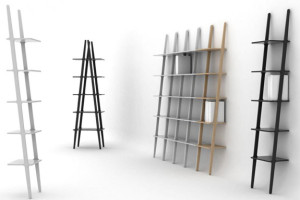
Flexible bookshelves by Swedese Libri - (Image Credit: Swedese Libri)
2. Nomadic Bookshelves – Created by Swedese Libri, these Nomadic Bookshelves are not renowned for their modern look but as a practical piece of furniture with adjustable legs that can be used as a free standing shelf or used in conjunction with another Swedese Libri shelf. Its flexibility also enables the shelf to rest comfortably on uneven floors and includes wall brackets with every shelf. Available in ash wood or black lacquer, these horizontal bookshelves are ideal for small spaces or as way to open up a room with an eye-catching and functional piece of modern furniture.
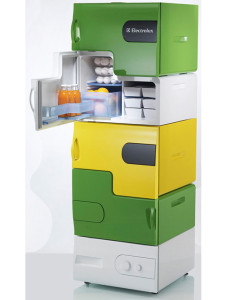
Modern-looking space savers for your food - (Image Credit: Electrolux)
3. Electrolux Flatshare Fridge – Fridge space can quickly diminish for people that live in a shared living situation. Electrolux, designer of functional and practical appliances recently debuted their stackable mini-fridges called Flatshare Fridge. These self-contained modules are placed on a base that then operate as mini fridges that can be stacked as a single unit going all the way up to five units. We especially love how you can personalize each fridge with its own distinctive patterns and look – creating your very own unique module to compliment your style and home. Currently still in development, we are all hoping this one hits the market soon.
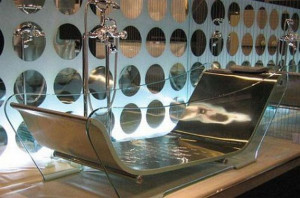
A glass tub for the ultimate in relaxation - (Image Credit: Wasauna)
4. Wasauna Glass Bathtub – While clear showers have been around for while, this is the first time we are seeing glass bathtubs. Created by Wasauna, the luxurious bath tub has a dimpled anti-slip design whose unit is surrounded by glass while the base is covered in stainless steel. The tub is also equipped with an adjustable and padded headrest for maximum comfort that is currently on “sale” for $3,200.
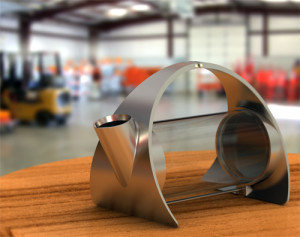
A teapot with a sleek edge - (Image Credit: Sorapot)
5. Joey Roth Sorapot – You would never imagine that this sleek and modern-looking apparatus was a teapot; however, at a closer glance you will see a sustainable teapot designed for both aesthetic appeal and function. Created by designer Joey Roth, the Sorapot, made from stainless steel, borosilicate (heat-resistant) glass and silicone can make two cups of tea in its clear modular tube unit that allows tea leaves to unfurl, naturally. The Sorapot is also designed to change depending on how it is cleaned as well as how it is held that will eventually matte. At $200 per pot, you will have to be quite the tea-lover to invest in this new product.
Don’t forget to like us on Facebook and follow us on Twitter!
• Follow us on Twitter @Relocation_News
• Become a fan of Relocation.com on Facebook

A few small changes can really enhance your home - Image Credit: http://www.outinhome.com/
By Faith Teel
Special to Relocation.com
The second day of January often brings a sense of relief: you’ve gotten all of your vacationing out of your system, and now you’re ready to roll up your sleeves and dive back into your daily life.
The first weeks of a new year are also a great time to spruce up your house. After all, you’re already taking down the Christmas decorations, so you might as well redecorate a little bit while you’re at it. Here are a few suggestions to get you started.
Get crafty. Are you snowed in with nothing to do? Why not get out those crafty projects you’ve been meaning to tackle? This is a great time of year to repaint an old lamp, make a collage for your bedroom wall or sew a new pair of curtains. Start the year with a little bit of artistic inspiration, and set a trend for the rest of the year.
Bring the outdoors in. Sometimes winter can make a house feel drab and glum. If you’re really longing for spring, stop by your local nursery or florist and pick up a few forced bulbs. You can also perk up your home by taking a cue from the Japanese, who change the artwork on their walls in response to the seasons around them. This winter, why not pick up an inexpensive poster that reminds you of warmth and sunshine?
Do a thorough housecleaning. A chilly day is ideal for cleaning your home from top-to-bottom, because household chores give you a little exercise without actually forcing you to go outside. Now is the time to dust the chandelier, clean the lint out of the laundry room, shake the breadcrumbs out of the toaster and re-fold all of the sheets in the linen closet.
Update your light bulbs. Especially if you have high ceilings that put your light fixtures out of reach, it’s easy to put off changing your light bulbs. You need all of the bright light that you can get in winter, so make sure that all of the bulbs in your house are working. While you’re at it, dust off any glass shades, and give the fabric ones a good scrub in the sink (or at least spot-clean them).
Get ready for spring. Speaking of warmth and sunshine, winter won’t last forever. Now is the time to plan next year’s garden. Even a small apartment balcony has room for a few planters. Use them as an excuse to page through gardening catalogs and dream of summer flowers.
Give to charity. This winter, take a few minutes to sort through your stack of canned goods and other dry food. Food pantries often get lots of donations before Christmas, only to fall short later in the season. Why not give those dusty tins to someone who will appreciate them?
Don’t forget your clothes closets. This is a great time of year to sort through your bedroom closets and get rid of any summer clothes that you’ll never wear again. (Hint: if you didn’t wear it last summer, you probably don’t need it.)
Patch it up. Need a little coziness on a cold afternoon? Try an old-fashioned remedy: mend your clothes and other household items. This is a great time to sit in a comfortable chair in the warmest part of the house and sew patches onto old bed sheets or fix a tear in your favorite skirt. A cup of tea and an audio book can round out the picture and turn an otherwise dull chore into a pleasant refuge from your worries.
Paint the town—or just the house. If you manage to catch a few days of winter thaw so that you can open your windows for ventilation, now is a great time to repaint your walls. Pale, warm colors are an excellent choice in winter, because they reflect more of that scarce sunlight. Even if you can’t get a warm enough day to repaint a whole room, get out your cans of touch-up paint and freshen up the spots where the kids have been leaving hand prints.
Having a home that’s bright and clean is a great way to beat the winter blues. As you while away the days until spring, get ready for the new year by cleaning house and freshening up your surroundings. It will keep you feeling energized and uplifted all season long.
Don’t forget to like us on Facebook and follow us on Twitter!
• Follow us on Twitter @Relocation_News
• Become a fan of Relocation.com on Facebook
December 31st, 2010 by
Admin
Categories:
design and decorate,
Do It Yourself,
exterior projects,
Holidays,
Home Improvement,
interior projects,
Moving,
Moving Day,
Moving Industry,
Storage Comments:
No Comments » 
Happy 2011! (Image Credit: AL.com)
By Serena Norr
It’s that time of year again; out with the old and in with the new. Part of that old might involve upgrading your home with a renovation or new design or throwing out your old clothes or moving to a new town or city – all exciting prospects that warrant a few pointers in the new year. As we say goodbye to 2010, we wish you the best of luck with your prospective change and have a few pointers to help you make your 2011 brighter, more exciting and more organized! Happy New Year from all of us at Relocation.com!
1. Moving in the New Year? Whether you are planning a big move across the country or a small move around the block, we advise planning ahead. All too often we hear stories of people scrambling for movers – only to use the first company that they find. We always advise researching three to five licensed moving companies from a reputable resource such as Relocation.com AND to have the movers come to your home for an in-house moving estimate. Taking estimates over the phone is a huge NO for 2011 – these prices are not binding and are subject to increase on moving day. Having movers come to your home allows them to see your belongings (thus determine the price) and this is also a great opportunity to ‘interview’ them – where you can ask them about anything from their insurance policy to how long they have been in the industry. No questions are off limits.
2. Decorating? Designing? Renovating? If you staying put you may want to spruce up your home with an exciting decorating project or an entire home renovation. No small feat, you should start by determine if the project is a necessity (leaky faucets) or a want (painting a room). The necessity should take precedence over the want and in some instances should only be handled by a professional. Be honest with yourself by what you can handle. You don’t want to start a huge project only to find out that you made a bigger mess that you started out with. As with finding a mover, meet with three to five contractors, architects or home improvement experts to discuss your project. They can also tell you how long they are expected to work in your home, what fees are involved and what the room will look after the project (if you designing). If it is a simple project, like painting, create a plan for yourself. Make a note of your budget, prospective color scheme and the estimated time line. Visit your local hardware store and bring home a few samples before you begin the job – also make sure to ask about what supplies you will need.
3. Out with the old in with the new. The New Year is a great time to get rid of some junk that you have been hoarding. Oftentimes we hold on to items that we no longer need or no longer realize that we even have. This turns into junk; leaving our homes filled with tons of useless stuff. Of course, some items are valuable or sentimental to us but still may not have a place in our homes. In those instances, consider keeping your belongings in a secure and climate-controlled storage facility. Going from room-to-room, evaluate your stuff by placing your items in a keep, toss or donate/store pile. Be honest with yourself about your needs vs. wants as well as your space restrictions. Items in the keep pile are necessities. Items in the toss and donate pile can be sold in a garage sale or donated to a local charity or to the Salvation Army.
4. Storage solutions. We are huge fans of storage – as mentioned above. This doesn’t only include housing your belongings in a self storage facility but placing your items in smaller organizational units to clear up some space. We love under-the-bed storage options such as this one from Bed Bath and Beyond and this modular closet system that organizes items in your closet. The kitchen and the bathroom are also major areas for clutter. Consider using roll-out under-cabinet drawers to contain and organize anything from products to dish towels.
Stick with your housing or moving resolution for 2011 – big or small – Relocation.com is here to help you every step of the way!
More Ideas for the New Year:
Don’t forget to like us on Facebook and follow us on Twitter!
• Follow us on Twitter @Relocation_News
• Become a fan of Relocation.com on Facebook
December 29th, 2010 by
Admin
Categories:
Celebrity Real Estate,
condos,
foreclosures,
Holidays,
Home Improvement,
homes for sale,
Moving,
Moving Day,
Real Estate,
rentals Comments:
No Comments » By Serena Norr
As 2010 comes to an end, we are optimistic that the housing market will improve – whether that means more families that are able to buy homes or those that don’t have to go through the foreclosure process. One way we escape is by perusing at celebrity real estate as a way to escape as well as send positive real estate vibes for those that need them. This week there were many sales including Pink who purchased a lovely estate in Malibu complete with a pool, gourmet kitchen and stone fireplaces. Michael Jordan also purchased a new home this week, actually two condos, for $3.2 million. It was also reported that President Barack Obama’s Hawaiian vacation home will soon be available for rent. Most of us, though, probably can’t afford the $3,500/per night rental fee. Although these home purchases and listings are extreme, we wish everyone a prosperous New Year in real estate – whether that means scoring your first apartment or buying your first home. Happy New Year!

Pink's New Home - Purchased for $11.85 Million. (Image Credit: The Real Estalker)
• Pink and Cary Hart Buy New Home in Malibu for $11,850,000
It was recently reported that pop singer Pink and her motorcycle riding hubby are expanding their family with the addition of a new a baby. The couple also recently purchased a new six-bedroom home in Malibu, California for $11,850,000. Enough to fit several children, this 6,800 square feet abode also includes seven bathrooms, stone fireplaces, wood-beamed ceilings, a gourmet kitchen complete with a breakfast room overlooking the sprawling Point Dume cliffs and one acre of land. The property, built in 2005, also includes their own aquatic sanctuary with a 25-yard swimming pool, outdoor pond and fountains.

Former Home of Poet Langston Hughes - Listed for Sale at $1 Million (Photo Credit: Sotheby's)
• Former Harlem Home of Langston Hughes on the Market for $1 Million
The former town house of poet and writer Langston Hughes was recently placed on the market for $1 million. Located in East Harlem, measuring 20×45 feet, includes four floors and a basement as well as five bedrooms and four bedrooms. Property listings from Sotheby’s describe the property as “needing a total renovation” with “plenty of room to design your dream home.” The historic home also includes eight marble wood fireplaces and original molding along with hardwood flooring and a 20×100 deep garden, which adds extra light to the home.

Michael Jordan's Swanky New Kitchen - Sold for $3.2 Million (Photo Credit: The Luxist)
• Michael Jordan Buys a $3.2 Million Dollar Penthouse in Charlotte
Michael Jordan, basketball Legend and owner of the Charlotte Bobcats recently purchased a 7,000-square-foot home in Charlotte, North Carolina. The two-floor penthouse (Jordan combined two units) comes equipped with its own private elevator, gourmet kitchen and outdoor space equipped with areas for grilling and gas fireplaces. The condo, located at The Trust, is also conventionally located within walking distance to the Time Warner Cable Arena where most of the Bobcats games are held.

Hawaiian Rental Where Obama Stays - Currently Listed for $3,500/Per Night. (Photo Credit: AOL Real Estate)
• Obama’s Hawaiian Vacation Resort Available for Rent
President Barack Obama’s Hawaiian vacation home, located in Kailua, is soon to be available for rent – that is, if you can afford the $3,500/per night fee. This private Oceanside resort (where Obama is staying until January 2nd) includes five bedrooms, 5.5 bathrooms and 4,951-square-feet of living space. Available for rent starting on March 20th, 2011, the scenic property also includes a three-car garage, a media room, a pool, and stained glasses and African mahogany fixtures throughout the home. Those interested in this rental should also know that there is a one-week minimum whose listing states that it could fit up to 10 people.
Don’t forget to like us on Facebook and follow us on Twitter!
• Follow us on Twitter @Relocation_News
• Become a fan of Relocation.com on Facebook

Toast to your new place!
If you have a friend or family member who has recently moved, you must have heard how difficult moving can be – ranging from deciding on a moving company to packing up all of their belongings. Although challenging, it can be one of the most exciting experiences for your friend or family member as they explore a new town or city. To help them acclimate to this new life and ease some of post-moving day stress, we suggest one of these inexpensive housewarming gifts as a way to welcome them to their new home. After all, there is nothing better than a gift from an old friend.
1. Wine Glasses. Nothing is worth toasting more than the end of the moving process. Purchase a set of two or four wine glasses from popular vendors like Create and Barrel or Bed Bath and Beyond, along with a bottle of wine. We also love the elegant wine carafe’s at Create & Barrel.
2. Coffee Mugs. If your friend isn’t a drinker, consider a set of fun over-sized coffee mugs or a practical travel mug so your new friend can get their java fix and head out on the road as they check out their new town.
3. Coffeemaker. Coffeemakers are relevantly inexpensive these days. Choose from a 10-cup or 12-cup coffee maker such as the Capresso Digital Coffee Maker or a model from Cuisinart. A nice French press is also a great gift that would be perfect with a bag of gourmet coffee.
4. Beauty Pack. For the female post-movers in your life consider putting a gift bag together with their favorite body wash, candles, lotion, nail polishes, cream, or facial mask. There is nothing she will love more than this mini-spa kit after moving day.
5. Tool Kit. A sensible gift filled with screws, a hammer, a screw driver, hooks, nuts and bolts that can help your friend as they place pictures on their walls or as they assemble new furniture. Not just for after moving, tool kits – ranging from electrical to portable models – are a practical and useful gift for anyone.
6. Food. Most likely, your friend will have gotten rid of most of his or her food before moving – at least the non-perishable items. Surprise your friend with a gift basket filled with fresh fruit, nuts, crackers and some cheese. If you live far from each other, you can order fruit baskets online from popular retailers like Edible Arrangements or sweets such as cookies and cakes from Mrs. Fields.
7. Plants. Greenery really has a way to spruce up a home – especially as your friend’s home is filled with unopened moving boxes. You can have plants delivered from a local nursery or if you live close-by consider bringing a bouquet of flowers to their new home after moving.
8. Pictures. Pictures such as an image of you and your friend or a scenic painting make for a nice personal gift. Consider ordering a 8 x 10 image and purchase a new frame for your friend. This warm gift may even inspire your friend to start decorating their new place.

It's beginning to look a lot like Christmas. How to decorate your home this holiday season.
(Image Credit: http://www.christmaslightsetc.com/)
By Faith Teel
Special to Relocation.com
This year has been a tough year on many budgets, but that doesn’t mean you have to hold back on the Christmas decorations. Instead, plan wisely, search for bargains, use what you what you have and create your own decoration as well. This holiday is about joy, not money. In this article, we’ll give you lots of tips for making or finding inexpensive Christmas decorations that sparkle with good cheer despite their humble origins.
Christmas for Kids
If you have children at home, now is a great time to fall back on traditional favorites. Keep in mind that we’re not the first generation to have Christmas on a budget; our parents and grandparents all knew how to “deck the halls” with things they already had at home.
Salt Dough Ornaments – Salt dough are like cookie dough, except that it doesn’t spoil and it’s inedible. It’s typically made of just salt, dough and flour, and any old-fashioned cookbook (or new-fangled recipe website) will have a salt dough recipe. Your kids can use salt dough to make decorative “cookies,” bake them, and then paint them with craft paint. Be sure to add holes for ribbon so that they can be hung on the Christmas tree!
Paper Chains – Paper chains are simple loops of paper combined to make a long garland that can be wrapped around your Christmas tree. They’re easy to make with a stapler or a pot of glue. Use ordinary construction paper, or up the ante with gorgeous wrapping paper or scrap-booking paper. (Children really appreciate good paper.)
Snowflakes – Every kid has cut dozens of snowflakes made from paper folded into six or eight sections. This year, jazz them up by using golden or silver paper, or try using colored paper in several layers so that the holes in one snowflake show the colors of the one behind it.
Popcorn Strings – One of the old-fashioned traditions that we’d like to see a return to is the string of popcorn on the tree. Use air-popped kernels for a long-lasting garland that doesn’t smell like butter.
A Sophisticated Christmas
Kids’ decorations are cute, but sometimes the Martha Stewart in your heart calls you to decorate with a more grown-up, sophisticated palette. Luckily, Christmas ornaments don’t have to be expensive in order to look expensive.
Paper Ribbons – This is the grown-up version of the kids’ paper chain. Get some lovely parchment paper or some elegant wrapping paper. Cut the paper into one-inch-wide strips and glue them end-to-end to make a long “ribbon.” In your best handwriting, use a magic marker to write the words of a favorite carol or poem on one side of the paper ribbon. Wrap your ribbon around your Christmas tree or hang it over a doorway.
Presents on a String – Save your tiny boxes throughout the year and wrap them in elegant paper. Run a string through them using a big darning needle, and then hang them in your house as a garland. Use bigger boxes as decorations on a fireplace mantle or a hall table.
Glittery Branches – Two of our best friends in budget decorating come together in this craft. Check your yard for shapely dead branches, and then spray them with metallic spray paint for a lovely winter sculpture. Hang Christmas ornaments from the glittery twigs.
Bring the Outdoors In – This is a great time to trim back that holly that’s been overwhelming your sidewalk. Look for pinecones and evergreen branches, too. We’ve even scored a branch of mistletoe when the landscapers were trimming it out of the trees at our local park.
Heavily Ornamented – Do you have more Christmas ornaments than you can fit on your tree? Why not hang them everywhere else, too? Chandeliers are prime candidates for Christmas ornaments, and so are doorways. Do you have a spare tree topper such as an angel or a star? Try topping the end of a stair banister or the finials of a bedpost.
Apples and Oranges – Another of our favorite decorating tips is to use tomorrow’s food for today’s decorating. Apples and oranges are lovely when heaped in a basket with a few pinecones and a red velvet bow. If you have a cupcake stand, replace the cupcakes with fruit to make an apple “tree.”
Dessert – Fruit isn’t the only decorative food. To quote that classic cookbook, “The Joy of Cooking,” “desserts give a hostess a chance to build a focal point.” An elegant cake can make a gorgeous centerpiece for any dinner party. If you’re not an expert at frosting, cut a paper “snowflake” and lay it over a dark cake (such as ginger or chocolate). Sprinkle the cake with confectioner’s sugar and then carefully remove the paper. The paper will leave a pattern in the sugar.
No matter how slim your budget is, you can always find a way to make a cheerful Christmas. Just stick to the old-fashioned essentials, and remember: it’s not about how much money is in your wallet; it’s about how much love is in your heart.
Don’t forget to like us on Facebook and follow us on Twitter!
• Follow us on Twitter @Relocation_News
• Become a fan of Relocation.com on Facebook

While we all don't have stacks of money lying around, it is important to give a little this holiday season - especially to service providers.
Tis’ the season for giving, which not only means giving to your friends and family members but giving to those that help you out throughout the year. According to etiquette experts, movers, nannies, day care staff and even garbage collectors should receive some form of compensation –- whether through a monetary or a thoughtful gift.
We scoured the web for the best tipping resource and found one on Gifts.com’s Holiday Tipping Advice Holiday Tipping Guidelines for 2010 whose guide are designed to reflect our tighter and cost-conscious budgets. Enjoy the holiday season this year and remember those that have been good to you throughout the year! Happy Holidays.
Holiday Tipping Guide Provided by Gifts.com
Babysitter
Budget: One or two nights pay
What to Gift: You can get away with a tip, but try a gift card instead — it’s like giving cash, yet it’s more personal. If you know her favorite interests, you can give a movie lover a Fandango gift certificate, a music lover an iTunes card, or a college-bound sitter a certificate to Target. Still not sure? A girl of any age loves to shop at Sephora. You can also add a special homemade gift from your child, like a drawing or craft project.
Hint: You don’t need to give an occasional sitter a holiday tip. But if she’s really gone above and beyond the call of duty or if you use the same babysitter often during the year, you should reward her for her hard work.
Full-Time Nanny
Budget: One week to one month’s pay (based on tenure) for both a personal gift and tip
What to Gift: Buy something your nanny wouldn’t get for herself like a designer handbag — it should be something that’s a special indulgence.
Hint: Avoid kid-oriented presents like a new baby carrier or diaper bag. You want to reward your nanny for her hard work, not add to it!
Day Care Staff
Budget: $25-$70 for each staff member plus a small gift from your child
What to Gift: Cash and gift cards are the best (and easiest) choices. But you should take the extra time to personalize your present with a card or a holiday token that your child picks out.
Hint: If only one person takes care of your child, you should give more generously, but if there’s an entire staff of people, spread the wealth. In this case, it’s okay to give less to each.
Coach, Activity Instructor
Budget: Less than $25
What to Gift: Remember that these are their jobs, not necessarily their only interests. Try something personal from your child, like a book or a drawing of the entire team.
Hint: If you’re not up for giving a gift, a simple handwritten thank-you note from you and your child is a great way to show your appreciation.
Teacher
Budget: $25-$100
What to Gift: A unique house plant is always welcome. But, you could also get the class to chip in for one big gift that’s more personal — like a cooking class or a kindle.
Hint: Check your school’s policy because gift giving might be against the rules. Gifts are usually given when your child has one teacher all day. Don’t feel obligated to buy presents for everyone.
USPS Mail Carrier
Budget: Non-cash gifts with value up to $20 — civil servants are not allowed to receive cash tips
What to Gift: If you want to reward for delivery through snow, sleet and rain, buy a gift card for a coffee shop near your carrier’s route or a cold weather accessory for those tough winter days.
Hint: An added non-cash token of your appreciation could be a glowing letter or email to a supervisor — it might even mean more than a present.
Assistant
Budget: $50 or more; take into account your position in the company and how long the assistant has been with you
What to Gift: Ask around for advice on your assistant’s interests like a certificate to dine at a fine restaurant or tickets to a big event. A stylish home accent is nice too.
Hint: Avoid gifts that are too personal like clothes or perfume, and avoid anything too practical. They’re practical for you all year round, this gift should give them a break!
Apartment Doorman
Budget: $10-$100 each
Hint: You don’t have to spread the tips equally—those who serve you more should get a bigger tip.
Building Superintendent
Budget: $10-$100 each
Hint: The IRS considers tips income, but most supers don’t want to declare their Christmas gifts so consider tipping in cash. You can also tip less if you tip throughout the year.
Country Club Staff
Budget: $50 for your regular servers, locker-room personnel, front-desk employees and golf professionals; $100 for head servers or special service
Hint: Cash tips during the holidays are appropriate regardless of the club’s tipping policy.
Dog Walker
Budget: One to two week’s pay
Hint: A great way to show your walker that you feel her pain? Also include a gift certificate for a pedicure to cure her tired feet.
Garbage Collector
Budget: $15-$30
Hint: Pay attention to who collects your trash. If your garbage man is really a truck driver who operates a mechanical arm that does all the work, there is no need to tip.
Gardener
Budget: $20-$50
Hint: If you use a service that sends a different gardener each week, don’t worry about tipping.
Hairstylist
Budget: Cost of one haircut
Hint: If the same person that cuts your hair, styles, and colors it too, you may want to give more.
Housekeeper
Budget: Up to one week’s pay
Hint: If you use a cleaning service and never know who shows up, don’t tip at all. But if the same housekeeper comes every week and does a great job, tell her with a holiday tip.
Beautician
Budget: Cost of one session
Hint: If the person who does your nails is the shop’s owner, they might refuse your cash tip. But trust us, either way the gesture will be appreciated.
Newspaper Carrier
Budget: $10-$30
Hint: If you tip your deliverer throughout the year, give a smaller gift at the holidays. Usually they’ll leave an envelope at your door. If they don’t, ask the company to add a tip to your bill.
Package Delivery (UPS/FedEx)
Budget: Less than $75
Hint: Each delivery company has their own rules: FedEx doesn’t allow cash or gifts worth more than $75, but UPS doesn’t have a policy. Don’t get them in trouble, do your homework first!
Personal Trainer
Budget: $60-$100 upon reaching goal, or cost of one session
Hint: If you’re going to add a gift to your tip, stay away from chocolates, candy or anything that’s not health-conscious.

A family celebrating the Festival of Lights
By Serena Norr
The holiday season is finally here and for many of us that means shuffling through stores in search of the latest and greatest toy or gadget, but we all know that this is not the true meaning of the holidays. Part of that includes staying focused on what is really important – spending time with family and friends including enjoying traditional fare, customs and music and simply being together. Starting with Hanukkah (or Chanukah), Relocation.com has the best ways for you and your family to celebrate this eight-day holiday known as the Festival of Lights.
Make Hanukkah cards. Cards are a great way to pass along well wishes to friends and family members and what better way to spread the message but by making a homemade card. Use old wrapping paper or images from old magazines or websites like Craft Creations, cut out the images and glue them on a piece of construction paper with a sealant like Mod Podge. Your children can also draw a picture on the front or you can glue on a family picture. Write your holiday greeting inside the card and include a small wallet-size picture of your family.
Make food together. Food is one of the central elements of Hanukkah and getting children involved is a great way to teach them about its preparation and traditional significance. Kids can help shred potatoes and onions for the latkes or prepare batter for jelly donuts. They can also help cut out cookie shapes or dress them with blue and white sprinkles. Other food items that they can help with: applesauce, cutting up carrots for pot roast or matzo ball soup or opening packages of noodles for noodle kugel.
Listen to music together. Play Hanukkah music at home throughout the eight days. Some traditional favorites include “Chanukah: Festival of Lights,” ” Spirit of the Holidays, O’ Hanukkah” or a modern classic like Adam Sandler’s “The Hanukkah Song.”
Arts and crafts. Aside from making Hanukkah holiday cards, children can create their own candles or menorahs. Candles are made from beeswax and menorahs can be made out of sculpting clay, which most craft stores have. Kids can decorate their menorahs using paint or markers to create their own personal and unique symbol of the holiday. You can also create a Hanukah scrapbook or collage using images that relate to the holiday and pictures of your family.
Read books. Books that discuss the theme of Hanukkah are great to enjoy over the holiday as well as teach lessons in a fun way. “Light the Lights,” “Latkes and Applesauce,” “Light the Candles: A Hanukkah Lift-the-Flap Book,” and “The Borrowed Hanukkah Latkes” are great book younger children. Older children might like “Moishe’s Miracle: A Hanukkah Story” or “No Such Thing as a Chanukah Bush, Sandy Goldstein.”
Consider a video. Kids also love videos and they can be an entertaining way to teach them about the values and principals of this holiday. Check out “A Rugrats Chanukah,” Chanuka at Bubbe’s” or “A Taste of Chanukah.”
Light the lights. Of course one of the well-know traditions of the holiday involves lighting of the menorah. Gather the whole family together and reveal in the beauty of the menorah, and perhaps your homemade creations. Traditionally, the menorah is placed in a front window in order to share the light with neighbors.
Play games. Games like dreidel, a spinning top, are traditional favorites during Hanukkah. The Player use candies or chocolate coins called gelt to play the game. When a player spins the dreidel, he or she will either take some treats from the pot, or put some into the pot.
Share gifts. Another part of the holiday includes eight days of gifts. Exchange gifts together and enjoy the act of giving to the people that matter the most to you.
Remember, holidays and traditions are best when they can be shared with others. Have a Happy Hanukkah!

Have too many clothes? Swap them or give them away before you move.
By Serena Norr
Now that you are moving you can actually see how much stuff you own; and most likely, it’s a lot of items that you didn’t even realize that you had. The beauty of moving is that you not only get a chance to start fresh – whether that be for a new job or the desire to explore a new town – but you also can get rid of extra baggage in the form of your old belongings. One way to get rid of your items is to have a swap party. This is a great way to have an intimate and free clothing exchange. Add some food and drinks and you have a free going away party – as your old clothes find a new home. Party down this weekend with Relocation.com’s clothing swap party guide.
1. Gather your stuff. Before the party can happen, you’ll have to organize your items into piles of what you want and don’t want. As part of your packing plan, consider what items are of value but those that you no longer have use for. This might include an expensive jacket that you no longer wear or old worn in jeans. Devise these items into a pile for your party. If you have time, wash and fold these items beforehand.
2. Organize a size box or items by type. During the moving process, organization is the name of the game. Place your items size into various boxes – this will also make it easier for your guests to know where to place their clothes. If you are swapping other items, consider organizing them by type – so books would go with books, DVDs with DVDs, etc.
3. Send out the invite. Now that you know what items you want to get rid of (er, swap), it’s time to send out the invitation. You will know how many invites to send out based on the size of your home – or wherever you may be having it. Send out a mass email or an Evite to organize your guest list. In your invite, you can also ask your friends to contribute to the swap by bringing a food item or drink – no one wants to swap on an empty stomach.
4. Get the list together. Now that you know who is coming, set up your list and do a little shopping. Since you have assigned your friends to bring some food and drink items, your shopping should be minimal. Consider some basics like hummus and pita bread, carrots, chips, wine or beer, water and fruit.
5. Party time, excellent. It’s almost time to partay! Before your guests arrive, arrange all of your clothes into their appropriate size box (small, medium and large) and set up your food and drinks. As your guests arrive, explain your organization system and start swapping!
With any luck, your old clothes, knickknacks and books will have found a new home – clearing up some space making it easier (and lighter) for you on moving day. Taking something is also not a big deal – but be sure to choose wisely. You don’t want to end up with more items than you had before the swap!
November 24th, 2010 by
Admin
Categories:
Celebrity Real Estate,
condos,
foreclosures,
Home Improvement,
homes for sale,
Mortgages,
Moving,
Plan Your Move,
Plan Your Relocation,
Real Estate,
Relocation,
rentals Comments:
No Comments » 
Nicole Kidman's Living Room - Listed for Rent at $45,000/month. (Image Credit: Luxist)
By Serena Norr
Although T-Day has been on our brain, the real estate industry isn’t far behind – especially within the exciting world of celebrity real estate. This week, Nicole Kidman listed her NYC penthouse for rent at a whopping $45,000/month. For those that fork over the bucks, you can look forward to leasing a glass-filled living room and a space with three bedrooms, 3.5 bathrooms and 3,785-square-feet of living space. Fashion director, Nina Garcia, is also on the Beat this week for placing her NYC condo on the market for $8.5 million dollars. This pre-war two-unit duplex includes 3.5 bathrooms, 12-foot-tall windows and a washer and dryer. Chelsea Handler and Jonah Hill also made an appearance on the Beat for buying homes in California with price tags of $6 million and $ 2 million, respectively. Whether you live a McMansion or an apartment, your home is only as important as those you enjoy it with you. Happy Thanksgiving!

Nicole Kidman's Living Room - Listed for Rent at $45,000/month. (Image Credit: Luxist)
• Nicole Kidman Renting Her NYC Pad
Actress Nicole Kidman recently placed her Perry Street apartment up for rent. Asking price? $45,000 per month, which even for NYC is a bit ridiculous! Kidman and her husband, Keith Urban, won’t have to worry about their real estate issues that long – they recently purchased a new luxury penthouse at 200 11th Avenue that comes complete with a sky garage – a car elevator that is accessible by a lift to one’s apartment complex. For anyone that can afford the rental on the Perry Street, they can look forward to having 3,785-square-feet, three bedrooms and 3.5 bathrooms – not to mention a glass-filled living room (designed by Richard Meier) that stretches the full width of the apartment, including views of the West Side Highway and the Hudson River. Kidman and Urban also own homes in Sydney, Nashville and in Beverly Hills.

Nina Garcia's NYC Condo for Sale - Listed at $8.5 Million. (Image Credit: The RealEstalker)
• Fashion Director Nina Garcia Lists NYC Condo for $8.5 Million
Nina Garcia, fashion director and “Project Runway” judge recently listed her four-bedroom NYC two-unit condo for sale at $8.5 million. Located on East 66th street, the condo was originally purchased for $3,700,000 for one-unit and then $1,221,900 for an adjacent unit to create a two-unit condo. Located in a pre-war building, interested buyers will have to put down 50 percent of the asking price and expect to pay $4,080 in monthly maintenance charges. The condo also includes 3.5 bathrooms, 12-foot-tall windows, 11.5-foot tall ceilings, a large living room, a doorman, chandeliers, a washer/dryer and a kitchen with modern appliances such as the brands Subzero and Gaggenau appliances.
• Martha Stewart Drops Price on Home from $15.9 Million to $13.9 Million
According to Housing Watch.com, Martha Stewart recently lowered the price of her Perry Street penthouse from $15.9 million to $13.9 million. Another Richard Meier-designed apartment, Martha Stewart’s lower Manhattan pad includes 5,000-square-feet of living space, an on-site fitness center and 11-foot-high windows.

Chelsea Handler's New Home - Purchased for $6 Million. (Image Credit: The RealEstalker)
• Chelsea Handler Buys $6 Million Dollar Home
Chelsea Handler, host of “Chelsea Lately” and author recently purchased a 5,600-square-foot home in Bel Air, California for almost $6 million (she paid $5,942,500). Her electronically-controlled gated home includes 5,572-square-feet of living space, an outdoor kitchen with Viking appliances, a gym, six bedrooms and seven bathrooms. There is also two family rooms, a den and a backyard with a 50-foot pool, a raised spa and an outdoor fireplace.

Jonah Hill's New Hollywood Compound - Purchased for $2 Million. (Image Credit: The RealEstalker)
• Jonah Hills Buys Los Angeles Compound for Under $2 million
Jonah Hill of “Superbad” and “Get Him to the Greek” recently purchased a new home in Los Angeles for $1,865,000. The new estate, built in 1959, includes 3,660-square-feet of living space, four bedrooms, 4.5 bathrooms, a storage room, a children’s playhouse and a detached guest house with a private bathroom. Other amenities include a fireplace, a sky lit kitchen with modern appliances and a modern suite that overlooks the swimming pool.
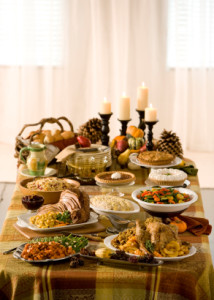
Dress Up Your Table This Thanksgiving.
By Faith Teel
Special to Relocation.com
Thanksgiving is a wonderful holiday that involves spending time with family and loved ones – not to mention a bountiful amount of delicious food that will have you stuffed for days. This is also one of the easiest holidays to decorate for since most of the key focus is on the food and less so on overly done decorations. With that being said, the only rule to keep in mind is that this holiday revolves around the dinner table. As long as you decorate with that in mind, you can have amazing decor on a small budget.
Help Guests Work Up an Appetite.
The easiest way to decorate any room is to pick a few bold colors, combine them with neutrals and stick to your chosen palette. Since Thanksgiving is all about food, you may want to stick with “appetizing colors,” which is how color experts refer to certain colors stimulate the appetite. These include many of the same colors that you see traditional holiday food: golden yellow, apple red, pumpkin orange, plum, brown, cream and sage green.
Inspiration from Nature.
Thanksgiving is also about the bounty of the autumn season, so a good place to get inexpensive (and elegant) decorations is the great outdoors. If you’re fortunate enough to have a garden, or if you live near a park, forest or other pleasant outdoor place, take a walk. As you stroll along, keep an eye out for natural materials that would look great on your table or in a big vase. For example, if you grew asparagus in your garden this year, pick a few of the dried, feathery ferns with their red berries still attached. Other great natural materials include pine cones, brightly-colored leaves, evergreen branches, holly, seed pods and feathery grasses. (Just make sure that if you’re picking plants from someone else’s land, you have the owner’s permission.)
Go Shopping.
If you live in the heart of the Big City and a nature walk is out of the question, drop by your local farmer’s market or grocery store instead. Food can be wonderful for decorating, and if you can eat your decor later, your grocery budget can double as your decorating budget. Pumpkins and squashes look wonderful in baskets, and if stored properly, they can keep until it’s time to bake them for Christmas dinner. Apples, oranges, lemons and pineapples, in a simple clear bowl, also make lovely displays and keep well.
Around the House.
The cheapest kinds of decorations are the ones that you already have. The first place to raid is your box of Christmas ornaments. This isn’t the time for snowmen and angels, but how about those red apple ornaments, or the ones shaped like birds, or the sparkly pears? Wouldn’t they look great hung from a chandelier?
I Want to Paint It Black (or Gold).
Keep an eye out for anything that can benefit from a coat of paint. Glittery gold or copper spray paint are excellent choices to shine up an old candlesticks or napkin rings.
For the Table:
Food, Glorious Food.
Of course, the centerpiece of any Thanksgiving holiday is the table. In fact, because the holiday is all about food, why not use the meal as the decoration, too? Make a pretty cake ahead of time and set it in the center of the table. (A covered cake plate can be useful to keep small fingers out of the icing.) Or tempt your guests’ appetites early by heaping chocolates or other pretty finger food in a tiered serving plate.
Bust Out the Good China.
Thanksgiving is a great time to get out the good china. If you’ve never been a fan of fine porcelain, you can still use your plainest everyday ware and dress it up with accessories such as cloth napkins and pretty goblets.
On the other hand, it’s tempting to hand out paper plates at big holidays like this, unless you can persuade someone else to wash the dishes. If you use disposable plates, there are still several ways to keep it classy. First, be sure to use sturdy plates that won’t let the gravy soak through. Solid colors will be more elegant than patterns. If you have a little bit of room in your budget, spring for classier disposables made from bamboo or clear plastic.
If you use disposable plates, try to use your best serving bowls. Even potato chips look better in a crystal dish!
A Little Bit of Fun:
Giving Thanks.
Because Thanksgiving is a family holiday, it’s a great time to involve your children in the decorating. Save your brown paper bags from the grocery store and help each child cut out a few leaf shapes. (You can also use colored construction paper.) Have them write something they’re thankful for, and then string the leaves together with a needle and thread. Hand your “Chain of Thankfulness” over a doorway or from a chandelier.
Old-School Decor.
Old-fashioned paper chains made from paper in pretty colors are another fun project. Update the idea by using pretty wrapping paper in brown and red and gold. (Kids really appreciate the chance to use nice paper.) You can also have the children use a needle and thread to string together plain popcorn.
For the Little Ones.
If you plan to seat the children at a separate table, consider adding a few fun features to keep them occupied while Mom and Dad eat. For example, you can cover the table with plain white butcher paper and put a basket of crayons (or washable markers) in the middle. You can even go a step further and add Thanksgiving-themed coloring books.
Family Fun.
The fun can continue into the evening with a “bobbing for apples” contest. To avoid the mess of a tub of water, hang apples from the ceiling by a long string. Have participants try to catch the apple in their teeth.
Sign Here.
Crafts don’t have to be limited to kids. This year, make a light-hearted “guest book” by drawing a pear-shaped turkey body on a nice sheet of parchment paper. Have each guest add a thumbprint in the tail area, than sign their names nearby.
Thanksgiving is a time to celebrate the things that make life sweet: a loving family and close friends. If you decorate with them in mind, you don’t need a big budget to have a welcoming home. Remember, a little creativity and using what you have goes a long way.